#instead of being a story about jason it turned into a batman-joker storyline again
Explore tagged Tumblr posts
Note
I don’t know what did they do


they fucked up my boy 😭
#muse talk#anon#robin lives spoilers#(not really My boy but. he gets the title bc i feel bad)#for those not in the know#the point of the robin lives run was to tell an alternate story#where jason survived his encounter with joker#and like. it felt very promising at first#but they just. completely threw it away with the last panels#instead of being a story about jason it turned into a batman-joker storyline again#and jason got. completely fucked over. he’s never allowed to heal
11 notes
·
View notes
Note
I kinda already commented and it felt weird to do it again? So I thought I’d ask here instead:
I just saw a post on tumblr that Batman did try to kill Joker and Superman stopped him??? And it was because Joker was somehow linked with Iran, and couldn’t be killed cuz it would start a war. And other Batkids also tried to kill Joker???
I’ve honestly always thought Batman didn’t kill Joker cuz he’s too popular a villain so it was just sort of waved off because of ‘Batman rules’ and publication reasons.
Is Batman almost killing Joker included in your fic? I have very little knowledge of the comics and hearing about newer versions overwriting previous stories makes me even more confused.
Congrats to you for having unlocked a secret level of rambling through deciding to send an ask rather than a comment. This would totally have ended up on AO3 below your comment. :p
And it is going below the cut because it's long as hell.
The scenario you've heard about was from the original run of A Death in the Family, which is the story arc where Jason was killed back in the 80s. In the aftermath of Bruce finding Jason dead (and Jason's birth mother dying shortly thereafter), he hunts for the Joker after realizing that the warehouse explosion didn't, in fact, kill the clown. Somehow (racism!) the Joker ends up being appointed as the Iranian ambassador to the UN. This was later retconned to the fictional country of Qurac, because even DC realized that was a step too far. In the scene after that fun little reveal, Superman is on hand to try and keep shenanigans to a minimum, the Joker predictably tries to gas the entire UN assembly chamber anyway, and then flees via helicopter. Batman, who has been trailing along this entire time in a rage, pursues.
He's planning to kill the clown. Superman, for reasons related to "we don't whack ambassadors and start wars," has been holding him back for the arc thus far. Helicopter pursuit turns into a helicopter fight, during which the Joker's henchman fires a spray of bullets that kills the pilot while everyone is on board and having a bad time. Batman exits the aircraft alive, intact, and furious, and doesn't give a single shit if the Joker died when the chopper hit the sea.
And then a month later the fucking clown comes back again like nothing happened. Only the entire setting has undergone a serious tone shift since Jason's death, which means you're gonna see a lot heavier, dramatic stories that have more significant body counts. Batman cannot get over the death of his son, because no, and eventually Tim Drake pops up in the middle of that death spiral with a hypothesis: "Batman needs a Robin."
He's not wrong.
He also doesn't go about it super gracefully, including an attempt to convince Dick to come back to the Robin mantle that goes nowhere, but eventually he convinces the Dark Knight to take on a third Robin. Unlike Dick and Jason, Tim is locked the fuck down for training and not allowed out in the field willy-nilly. And when he does go out, he is ferociously competent.
Incidentally, this is because the writers/editors realized that after the child murder storyline they'd just done, Batman had to have one hell of a reason to ever take on another kid sidekick. And they needed to try and drag the Robin role's popularity back up, since killing a kid sidekick was also a symptom of DC's tanking sales at the time; the whole thing was ultimately a publicity stunt. It was a bad idea and now we just live with it.
So Tim is, broadly, never portrayed as incompetent in any aspect aside from maybe high school socializing. I don't think he gets kidnapped even a tenth of the number of times Dick did during his decades-long career as Robin. Certainly never falls for a honey trap plot or anything like that.
But yeah, the meta reason why the Joker never dies is because he's an iconic villain who drives plots. But unless you step out of the main continuity, he's also never just been a "no-frills funny" villain since.
ANYWAY.
As far as the rest of the Batfam taking a swing at the Joker, there's one incident that I can recall off the top of my head.
Dick Grayson, currently Nightwing, wasn't especially close to Jason while he was alive. During Jason's original run, they had a cordial (if brief) relationship, but they basically didn't get any storylines together, so it's hard to really tell how strongly they bonded. After Jason died, Dick began experiencing...I wanna call them chronic night terrors. The idea is that a boy in a Robin costume is falling, and falling, and Dick can never save the kid.
I'm sure it has nothing whatsoever to do with his dead brother, no sir.
So, some time later, the Joker gets told he has terminal cancer by a psychiatrist who assumes that if the clown was convinced he was going to die, he might try reforming or something. A terminal turnaround. Lots of people do that, right?
He assumed wrong.
The Joker goes on an utter tear, doing all sorts of escalating villainy that starts with gassing everyone he can get his hands on, including other Arkham inmates. Somewhere amid this rampage, Robin III goes missing and the Joker cheerfully tells Nightwing that yeah, he killed the kid. And he has the gall to bring up Jason in the middle of all the gloating. By name. (The Joker knows Jason's name due to some nonsense involving Crane and Fear Toxin hallucinations and Batman in a prior story arc.)
And Dick
fucking
SNAPS.
Pummels the Joker right there on the floor. Barehanded. No sticks, no pausing, just beats him to death.
Two seconds later, a very alive (if hurt) Tim manages to get there and go "oh god what happened." Because Dick is not doing well! He has a crisis about killing a dude, no matter how terrible. He never thought he'd go that far.
Batman swoops in and resuscitates the clown. In the time between Jason's death and The Joker's Last Laugh, he has apparently decided that it's more important to keep Dick from suffering a breakdown than it is to kill the clown. DC editorial was gonna keep him alive either way, but whatever.
And now for the third part of my ramble.
As for Under the Red Hood, Jason's death is seriously streamlined for the film. In this version of events, none of the UN chicanery happens. Ra's al Ghul hires the clown for a distraction job while trying to crash the world economy (again) and whoops, the clown killed Batman's son. Crowbar, bomb, whatever. Before Jason's body can be buried, the League of Assassins steals it, hucks Jason into the Lazarus Pit, and now he's alive again!
Except, given how he died and how long he spent dead and how that interacts with the magic, he wakes up as a berserk ball of rage and pain, kills two of Ra's al Ghul's guards with his bare hands, escapes, falls into a river, and disappears.
...So much for making that whole thing up to Batman. The League of Assassins just quietly lets Bruce bury a latex dummy and doesn't ever bring it up.
Cut to Gotham, years later, when Red Hood is tearing up the place and Batman goes "Ra's al Ghul, what the fuck" and the whole story comes spilling out.
In A Ninja's Guide to Gotham, Jason's dropped hints in his narration that he was actually with the League of Assassins for a while, even before going 'round the world training with assassins and stuff. The Lazarus Pit just got him back to full functionality. So, you can assume it leans more on the comics' "spontaneous resurrection" scenario.
If Bruce ever tried to kill the Joker while Jason was dead, Jason doesn't know about it. And because we haven't been in Bruce's head, there's no indication either way.
(Bruce makes mention of how easy it would be kill the Joker in the film, but that he could never come back from doing so. It is not specified if he made the attempt or just thought about it a lot.)
I've been holding back on Jason's and Bruce's accounts of events because they're both owed a moment of dramatic catharsis (and shouting). You can generally rest assured that it'll be more likely to be a mix of events than a pure account of any one take on what happened in the warehouse that day.

Thanks for setting off an exposition bomb~
#a ninja's guide to gotham#jason todd#bruce wayne#batman#dick grayson#tim drake#asks#anonymous#comics are weird#so weird that there's not really a simple answer for a lot of things#tl;dr: none of the POV characters so far know the truth
80 notes
·
View notes
Note
It’s me again. (The anon that just asked you a billion questions about Jason’s death.) Also wondering: what do you think of the Killing Joke and Babs’s role as Oracle, and how do you think her and Jason’s “rebirths” can be compared? (Sorry for all the English class ass questions. I’m just so interested by your post. I never thought about the classicism behind Jason’s return as Red Hood but now all the wheels are turning.)
it's so immensely curious to me, because there's this parallel of both babs and jason being essentially fridged (well. jason got boyfridged. sidekick-fridged. sonfridged. i'm aware this term is usually used in relation to women.) but barbara's trauma stops being a plot device for other characters. it becomes a set off for her own storyline about healing and reclaiming her life instead. and the thing is, she succeeds! her life might have been altered by the joker, sure; but she refuses to believe that he made her in any way that matters. she refuses to let her whole life be dictated by it, and she recognises that she's so much more. she lives up to her potential, no matter the constraints.
and then you have jason. jason who is relentlessly victim blamed through decades after his death. jason's death never stops being vital for how other characters are written. this creates a sort of tension in which jason's voice as a victim cannot be central to the story. he has to remain a ghost, even alive; bruce's reminder of his "biggest failure".
and so, jason's act of assuming the red hood identity might be intended as a reclamation of what he fears, but it ironically reduces him to his trauma. let's be honest; this is not some neat bruce being afraid of bats -> taking batman as his name parallel. and you see, maybe jason's action of reclamation could work if it was used for catharsis; if he could later abandon it and go on, reinvent himself, as barbara did. but it's been years and it doesn't happen (even with countdown attempting to kick this off). he never gets to really learn that he is more than what happened to him; he's stuck in a vicious cycle of trying to free himself from his trauma, failing to understand that what he's actually doing is centring his whole life around it.
the reason for which this is how it plays out is def influenced by classism. the whole 'rebirth' (as you called it) itself is already affected by it; to go back to our comparison, for barbara to make a comeback, there was no need to retcon and rewrite her whole character. for jason, some "fatal flaw" was needed – and winick did not even care to make any of his original personality traits into it (like his love. kindness. sensitivity. it would work, goddamit, jason crossing the line because he cares too much and can't stop caring and has to do everything in his power to try to fix the world, no matter the cost, no matter the blood on his hands). instead, we get jason being overly aggressive and quick to anger; something very conveniently consistent with framing poor people as inherently likely to become criminal and somehow evil.
so i'd say, barbara's invention of oracle is a rebirth, while jason's invention of red hood is more of a reburial.
#god i'm so sorry anon this got buried in my inbox.#it's embarrassing to reply so late but...#i love english class questions!!#this was actually so fun to consider#this is also why i would like to see ostrander's take on jason... alas#dc comics#jay meta#jason todd#barbara gordon#red hood#answered
58 notes
·
View notes
Text
Timeline: Batman
google doc / ao3
This is my best attempt at a post-crisis timeline based on age-- specifically Bruce’s age every time he adopted and/or met one of his children.
List of events:
Bruce’s parents die
Bruce becomes Batman
Dick’s parents die
Dick becomes Robin
Jason becomes Robin and is adopted
Jason dies
Tim becomes Robin
Cass appears
Dick is adopted
Tim is adopted
Cass is adopted
Damian becomes Robin
I’ll be citing my work by issue and panel. This isn’t my most organized work, and I don’t know how well tumblr will let me translate it, so I do recommend the google doc. I imagine the image quality here won’t be great.
Notes:
This is a post-crisis timeline (1986-2011). I’ll be referencing a few pre-crisis panels, but I won’t be touching the New 52 or anything after it. That’s a different game of ball with its own, extremely bad, timeline.
Crisis on Infinite Earths is a 1985-1986 series that rebooted the DC timeline and altered some backstories, including Jason’s. Pre-crisis, his backstory was almost identical to Dick’s. Post-crisis, he changed to the “steal the wheels off the Batmobile” origin. Anything written before 1986 is a weak source for my purposes.
My original question centered around Bruce’s age through the process of meeting and acquiring his children. In this timeline, those children are (1) Dick Grayson, (2) Jason Todd, (3) Cassandra Cain, (4) Tim Drake, and (5) Damian Wayne. I was envisioning an interview where the kids explain their family timeline to outsiders. I did not anticipate the project taking this long.
We’re talking about 72 years of content here, which means decades of contradiction, conflation, and rewrites. I’m pretty satisfied with my work product, but please understand that there are no perfect answers. I’m going to cite my sources, and I’ll do my best to explain why I chose those sources specifically, but it’s pretty likely that for every panel I pull, there will be others with different numbers. We’re all going to have to live with that.
Event timeline
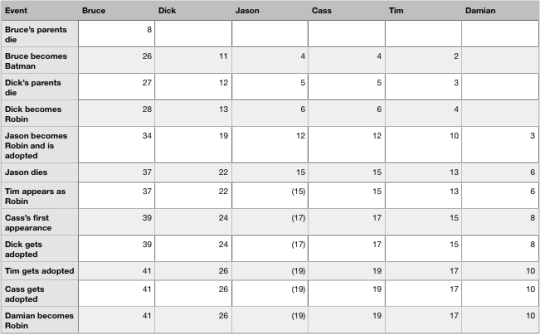
*I’m defining Jason’s age by the time elapsed since his birth, but you could make an argument for using time he has been alive, which is, of course, different. That’s why the parentheses are there.
Age differences

As Robin

----------
Bruce’s parents die
Pretty consistently, Bruce is written as eight years old the night his parents died.
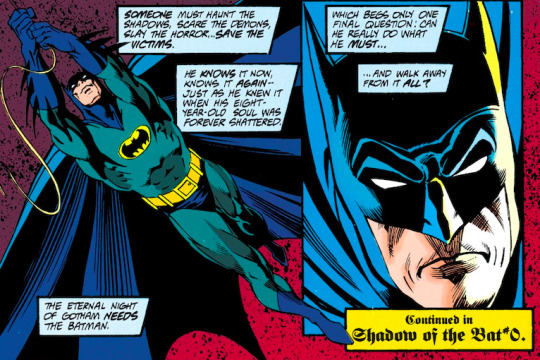
Detective Comics #0 (1994)
This is a zero issue where Bruce thinks back on his origin story. It was written long after Crisis on Infinite Earths (1986), and I tend to give a lot of weight to ages written in summaries of past plot lines, my reasoning being that it’s easier to be consistent in one issue than it is to be consistent through a month to month story.
Bruce first appeared as an adult in Detective Comics #27 (1939), and the Waynes were already dead at that point, so flashbacks are the only available material anyway.

Gotham Knights #6 (2000)
The text is Hugo Strange talking about Bruce, and the image is Tim and Dick playing at Wayne Enterprises.
I’ll take a second here to note that I did find at least one alternate age for Bruce— in Superman/Batman Secret Files & Origins (2003), Bruce was 10 when his parents died. I’m disregarding that in favor of the stronger 8 year old timeline, especially in light of Batman #404 (1987).
Batman #404 is the beginning of Batman: Year One, which was explicitly written to clarify the Batman timeline post-crisis, and it’s the basis of most of my calculations for Bruce and Dick’s ages.
----------
Bruce becomes Batman
According to Year One, Bruce was 26 years old when he became Batman. I’m using his age at his parents’ deaths, his age when he returned to Gotham, and his 18 year timeline.
Batman #404 puts Bruce at age 25 when he returned to Gotham in January.
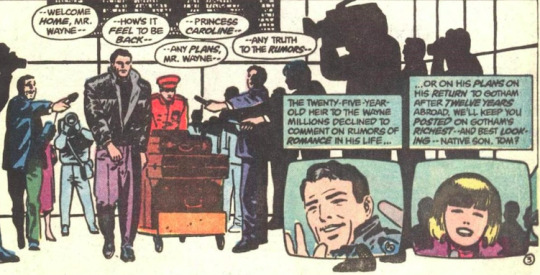
Batman #404 (1987)
Bruce gives his dramatic, “Yes, Father, I will become a bat,” line in March. In the same scene, he says that it has been 18 years since his parents’ deaths. Knowing that they died when Bruce was eight, that puts Bruce at 26 years old the day he became Batman, which makes sense considering Bruce’s birthday is usually set at February 19th.
He was 25 in January, turned 26 in February, and became Batman at 26, 18 years after his parents’ death.
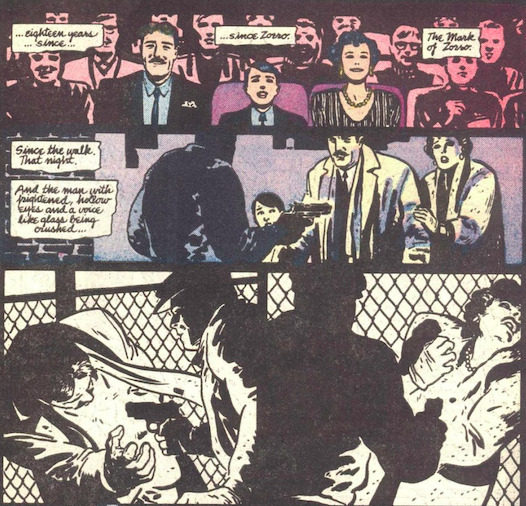
Batman #404 (1987)
Post-crisis, DC built timelines off the “Year” model. Year One is Batman’s beginning, and events after that are measured by how far away they are from the year Bruce became Batman. I’ll be using the Year model for Dick’s life events next.
----------
Dick’s parents die
The Graysons died in Year Two. Using the Year Model, Dick was 12 when his parents died, and Bruce was 37.
Year timelines appear a fair amount, especially in issues titled “Secret Files & Origins.” I pulled this bit from Batman Secret Files & Origins (1997) because it was the easiest to screenshot.
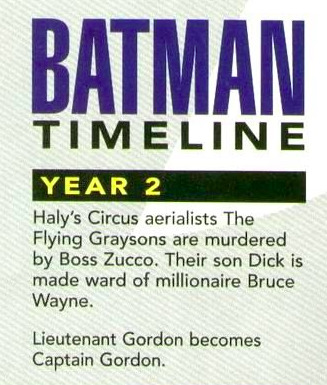
Batman Secret Files & Origins (1997)
Year Two would place Bruce at 27 years old. I’m calculating Dick’s age backwards, based on him being 13 years old during Year Three.
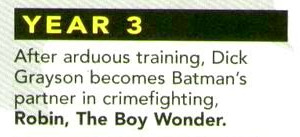
Batman Secret Files & Origins (1997)
----------
Dick becomes Robin
Dick became Robin in Year Three, when he was 13 years old and Bruce was 28. I’m using two different issues to calculate the number.

Batman #441 (1989)
Batman #441 is from Tim’s introduction story. It takes place “months” after Jason’s death. We’ll get to that part. In Batman #441, Tim asked Dick to be Robin again in order to help Bruce, who was visibly unstable after Jason’s death. Dick says that he can’t go back to being Robin, just like he can’t go back to being 13 years old. The strong implication there is that Dick became Robin at 13, which corresponds to Dick’s statements in Batman #416 (1988).
In Batman #416, Dick as Nightwing returns to confront Bruce about Jason becoming Robin. He says that he was Robin for six years, and he stopped being Robin at 19.
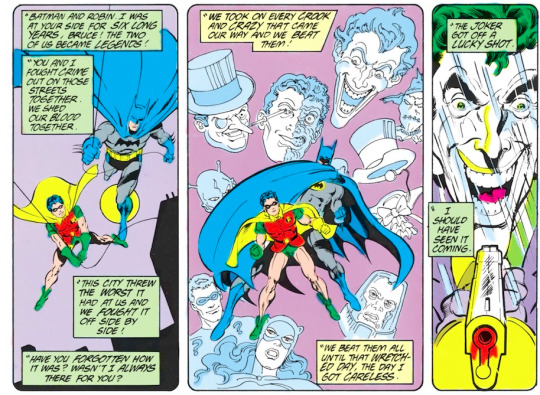
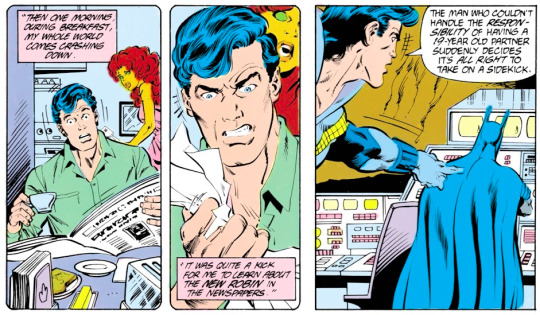
Batman #416 (1988)
If Dick stopped being Robin at 19, after 6 years, that would put him at 13 when he debuted as Robin, the same number from Batman #441 (1989).
Dick was 13 during Year Three, so 12 during Year Two, the year his parents died. Those numbers answer the first bit of my original question. I wanted to know how old Dick and Bruce were when Dick became his child. It’s a bit more of a complicated question for Dick, since he was originally Bruce’s ward, then adopted as an adult.
Based on the timeline so far, Dick became Bruce’s ward at 12 years old, while Bruce was 27.
----------
Jason becomes Robin and is adopted
As previously discussed (see Notes), Jason’s timeline is complicated by Crisis on Infinite Earths (1985-1986). Pre-crisis, Jason first appeared in Batman #336 (1983) as a former circus acrobat very similar to Dick.
Jason’s origin story reboots at Batman #408 (1987), which describes the switch-off between Dick and Jason. I’m building a lot of my timeline off of that issue. At the beginning, Dick gets shot by the Joker, and as Bruce carries him away, the media ask if Robin is dead. Dick isn’t dead, but back at the manor, Bruce decides to retire Robin as a role, based on the idea that crimefighting is too dangerous for a child.
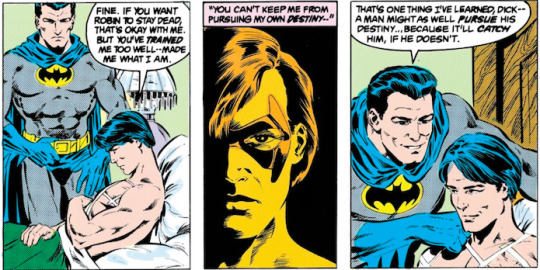
Batman #408 (1987)
This version is more or less from Bruce’s point of view, but there’s a contrasting version from Dick’s point of view later, in Batman #416 (1987). That one has a significantly different tone, and I already cited it once (page 13) because Dick talks about his age and the amount of time he was Robin.
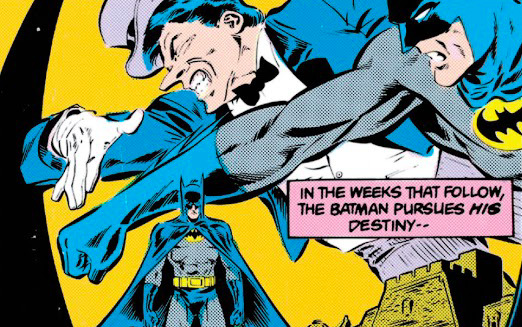
Batman #408 (1987)
The second part of the issue takes place “weeks” later. Bruce goes to Crime Alley to mourn his parents on the anniversary of their death. He comes back to find that somebody stole the wheels off the Batmobile. The somebody was Jason, and by the end of Batman #409 (1987), Bruce is calling Jason “Robin.”
Batman #408 (1987) seems to divide Dick’s departure and Jason’s introduction by only “weeks,” in the post-crisis reboot. Dick’s version of the story in Batman #416 (1987) is much less charitable to Bruce— instead of ending on a panel of Bruce smiling, it shows the aftermath of Dick in tears as Bruce walks away. Dick goes on to describe leaving the house, going to college for a semester, then dropping out. According to Dick, Bruce didn’t even say goodbye.
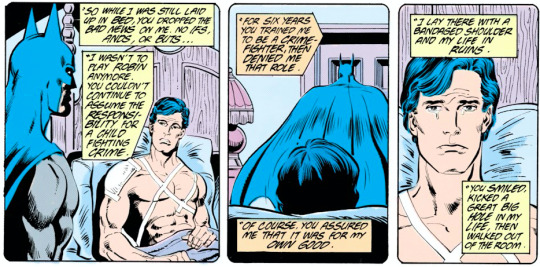
Batman #416 (1987)
I don’t think the stories are contradictory; they’re just different experiences of the same events, separated by only eight issues. Dick tells us that he was 19 when he left Wayne Manor, and Bruce chooses his new Robin “weeks” later.
As a summary, we know that Bruce’s parents died when he was eight, and that 18 years passed before he became Batman at 26. One year later, Dick’s parents died while Bruce was 27. One year after that, Dick became Robin at the age of 13. From those facts, Bruce is 15 years older than Dick.
All of my calculations of Bruce’s age are based off of the age gap between him and Dick. Dick was 19 when Jason became Robin, so we know that at that time, Bruce was 34. We also know that at that time, Jason was 12.
I can’t show a source for that number because it appears on the letter page of Batman #408 (1987), Jason’s introduction.
Even after a significant amount of investigation, I can’t find a copy of the letter page, but it’s cited by enough secondary sources for me to be comfortable using it. That issue is specifically written to show Jason’s origin, so it makes sense that it would contain Jason’s age at inception, even if the number wasn’t in the actual exposition.
From Jason being 12, we can establish a seven-year age gap between Jason and Dick, who was 19 at the time. Now we know Bruce, Dick, and Jason’s ages, and the age differences between them.

Back to my original question— when did Bruce acquire Jason? We know that Bruce was 34 when Jason became his ward, and Jason was 12. The next question, however, is when did Bruce adopt Jason? On this one, I’m making an educated guess.
Again we have to differentiate between pre-crisis and post-crisis timelines. Pre-crisis, there’s a full storyline about the fact that Bruce did not adopt Jason, although not for lack of trying. In Batman #374 (1984), the Child Welfare Bureau investigates Bruce when it notices that Bruce has not adopted Jason— and is not even, in fact, his legal guardian.
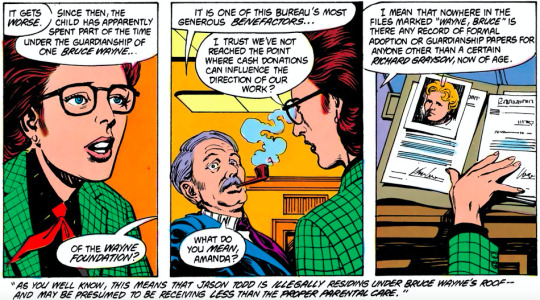
Batman #374 (1984)
The rest of the storyline is about Jason’s custody. A villain named Natalia Knight (Nocturna) adopts Jason in an attempt to get Bruce to marry her in order to become Jason’s father. In the court scene in Batman #377 (1984), Bruce says that he filed to adopt Jason sometime beforehand, although it’s unclear to me whether he means he filed between those issues or the CWB documents were incomplete.
Natalia does adopt Jason in Batman #378 (1984), and he briefly lives with her before returning to Wayne Manor in Batman #381 (1985), directly before the reboot.
I’m including all of that for two reasons: first, I do think it’s important to clarify both this version and the post-crisis version I’m about to address. Second, I spent years under the impression that Bruce adopted Jason pre-crisis because of one, well-known scene.
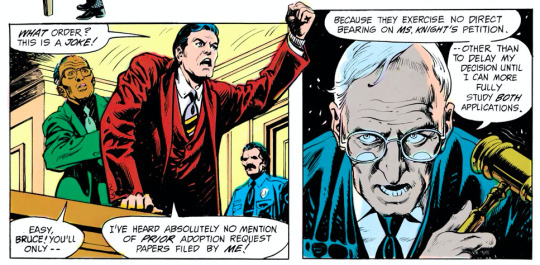
Batman #377 (1984)
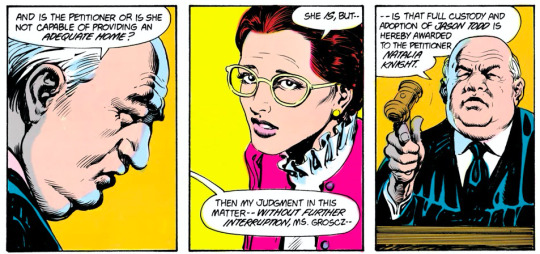
Batman #378 (1984)
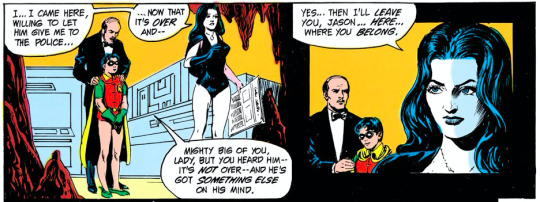
Batman #381 (1985)
Donna Troy gets married in Tales of the Teen Titans #50 (1985). At the wedding, Bruce and Dick have a conversation about Jason and about their own relationship. A few of those panels get spread around because they contain what I would consider a defining moment between Dick and Bruce.
I’m certainly not complaining about the amount of times I’ve seen the wedding conversation, but I think that, in regards to Jason, seeing just those panels has created a misconception.

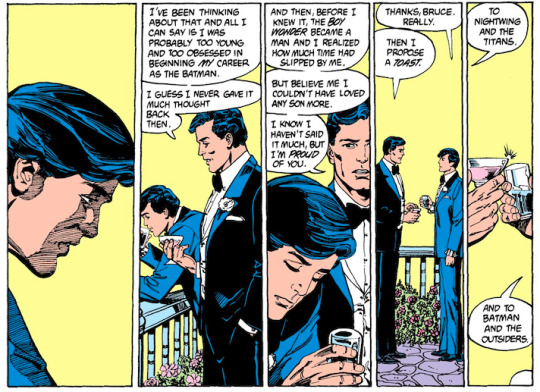
Tales of the Teen Titans #50 (1985)
Without context, it looks, at least to me, like Dick is saying that Bruce has adopted Jason pre-crisis, which isn’t true. This issue takes place between the Natalia adoption in Batman #378 (1984) and Jason’s return to the manor in Batman #381 (1985), and the panels directly before the exchange make that clear. I just didn’t see those panels until I looked through the whole issue for this project.
I’m reasonably certain that in the past, I publicly cited this issue as evidence of Jason’s adoption, and I was wrong about that. [Note: As it turns out, I was only partially wrong. See section Correction.]
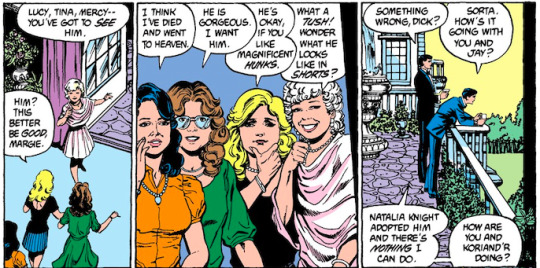
Tales of the Teen Titans #50 (1985)
As we see, the wedding conversation is in the context of the Natalia adoption. With that cleared up, and with the pre-crisis timeline filled out, let’s move to post-crisis.
In my brief read-through of Batman #404-427 (1987-1988), I didn’t find any direct references to Jason’s status. Those issues begin at the reboot and end at Jason’s death. However, Dick and Jason’s statements after the fact do tell us that post-crisis, Bruce did adopt Jason.
In Batman #436 (1989), Dick returns to the manor in the direct aftermath of Jason’s death, and while he is there, he sees that Bruce removed any trace of Jason from the house. There aren’t any trophies in the Batcave, and there aren’t any pictures of Jason on the nightstand displaying Bruce’s family photos.
Dick says that Jason was Bruce’s son.
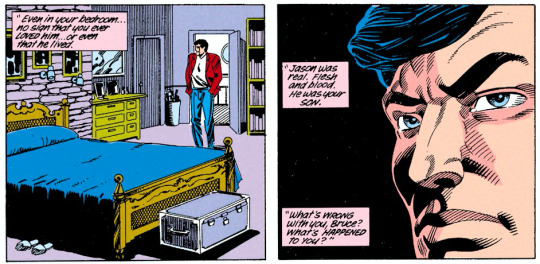
Batman #436 (1989)
I think it’s fair to ask whether Dick is being literal here, because even if Bruce hadn’t legally adopted Jason, it would still be more than appropriate to call them father and son. I’m not going to place my opinion solely on this kind of statement, even if it does appear pretty regularly from 1988 to the end of the timeline.
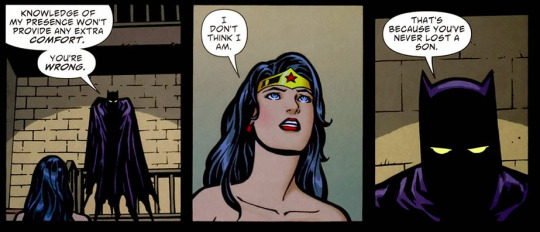
Green Arrow/Black Canary #4 (2007)
We get a more definite answer later, during Tim’s first appearance. In Tim’s origin story, he deduces Batman and Robin’s secret identities after he sees footage of Robin doing a type of flip that only the Flying Graysons could do. Tim was at the circus the night Dick’s parents died, so he saw Dick do the flip there, then saw Dick become an orphan.
Because Tim knew that Dick was the first Robin, he correctly identified Bruce as Batman and Jason as the second Robin. He tells Dick all of this in Batman #441 (1989).
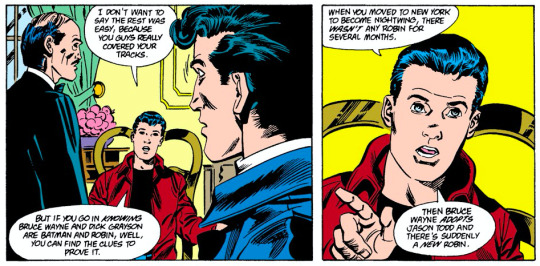
Batman #441 (1989)
Tim does specifically use the word “adopts” here, and that’s good enough for me. The last part is guesswork— I don’t know for certain how old Jason and Bruce were when the adoption took place, but I’m electing to say Jason was 12, the same age as he was when he became Robin.
I picked that number both out of convenience and because Tim seems to be putting Jason’s adoption and the second Robin’s appearance at around the same time. With that in mind, I think that Jason was 12 years old both when he became Robin and when Bruce adopted him. Using the age gap we already established, that would put Bruce at age 34.
Circling back to my original question, Dick became Bruce’s ward when Dick was 12 and Bruce was 27. Jason became Bruce’s ward, then adoptive son when Jason was 12 and Bruce was 34.
At this point in the timeline, Bruce is 34 with one former ward and one adopted son.
----------
Correction
A few days after I wrote my section about Jason’s appearance and adoption, I realized that I was missing a panel citation in my discussion of Jason’s death. The panel is from New Titan #55 (1989), and you’ll see me cite it when I talk about Jason’s death certificate.
New Titans #55 (1989) is the issue where Dick, who is with the Teen Titans, finds out about Jason’s death. While I was combing through the issue for the panels I wanted, I reread a scene I had completely forgotten about. Dick goes back to the manor to speak to Bruce, and it doesn’t go well.
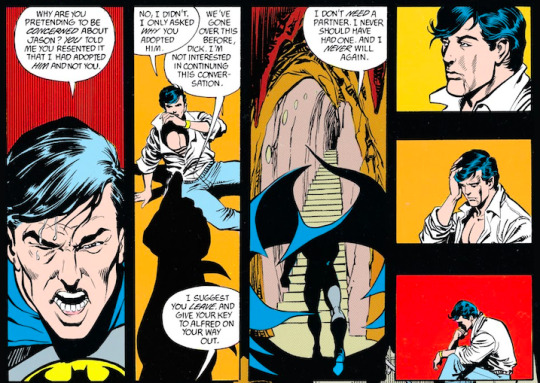
New Titans #55 (1989)
I have three comments here. First, I do think this scene is inconsistent with the simultaneous story in the Batman title. In this version, Dick and Bruce have a very aggressive confrontation, but in Batman #436 (1989), Dick appears to be returning to the manor for the first time since Jason died, and there isn’t any reference to a prior fight.
Putting that aside, Bruce does explicitly say that he adopted Jason, and that’s more, stronger verification of a post-crisis adoption. Lastly, it’s pretty clear that Bruce and Dick are talking about the wedding scene.
I already explained that the wedding scene is pre-crisis, and in the original text, that conversation is about Bruce wanting to, but not being able to, adopt Jason. New Titans #55 (1989) carries the wedding scene into post-crisis canon, changing the language in the process. In this version, Bruce has adopted Jason.
I was still wrong about the wedding scene because in the past, I used it as evidence of a pre-crisis adoption. It isn’t pre-crisis evidence, but it is, in a roundabout way, evidence of the post-crisis adoption. I wanted to clear that up before I move on to Jason’s death.
----------
Jason dies
Jason’s death is by far the shakiest point on my timeline, but I’ve chosen to put him at 15 the day he died in Batman #427 (1988).
I think it’s safe to say that Jason was either 14 or 15 when he died, and my basic conclusion is that running numbers doesn’t give me a definite answer. There’s a cop-out option based on an extraordinarily poor source, and I’m taking the cop-out.
The general consensus seems to be that Jason was 15 at his death, citation to Jason’s death certificate. Jason’s death certificate appears in two different places, and I think most folks conflate the two.
To my knowledge, the only copy of Jason’s death certificate in full appears in The Batman Files (2011), where it does list Jason’s age as 15.
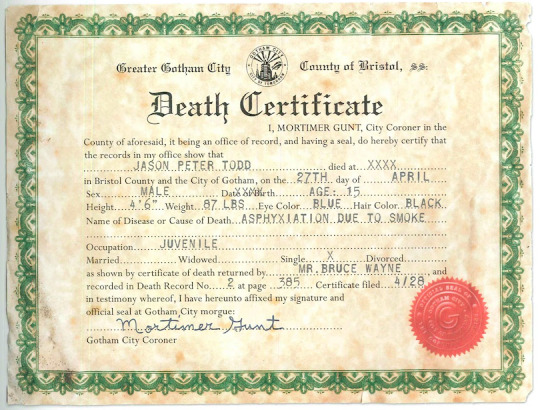
The Batman Files (2011)
Now there is a partial copy in Batman Annual #25 (2006), which I would argue is a very reliable reference when it comes to Jason. That issue is part of the Under the Red Hood story, the one where Jason returns to Gotham for the first time after his resurrection. In fact, the specific annual issue has a timeline for Jason’s events counting forward from his death.
Here’s the problem: the issue doesn’t say his age at death. The partial copy of his death certificate looks like this.
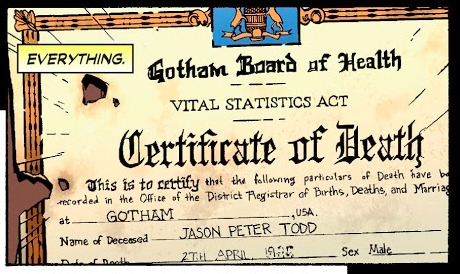
Batman Annual #25 (2006)
I think that when most folks remember a death certificate, they think of this one, the one from a very important issue, instead of The Batman Files (2011) which, as noted, is a very bad source.
I have three issues with The Batman Files (2011): the format, the publishing date, and the other information on the certificate. First, The Batman Files (2011) isn’t a comic book at all. It’s a commemorative book published in collaboration with DC in 2011. Now I don’t think that fact completely removes the book as a source, but it certainly damages its value as one.
My problem with that date, 2011, is that it’s the year the New 52 premiered. I called it a commemorative book because it’s meant to be a look back at a fully complete timeline, a kind of “this is us saying goodbye” product. The date and format alone make me hesitant to cite the certificate, but on top of that, the certificate is inconsistent with prior canon.
I am intimately familiar with retcons and conflicting numbers in the DC timeline. I made a point at the beginning of this paper to tell you that although this is my best attempt to make a cohesive timeline, assuming that I can carve out a cohesive timeline is fundamentally flawed.
I’m not saying that a single contradictory number is enough to make me disregard a source. I am saying that in this particular conversation about an already suspect source, I’m going to take inconsistency into account.
In New Titans #55 (1989), the issue from Corrections, Dick finds out about Jason’s death because a team member notices Jason’s status is set at “unknown.” Dick uses Bruce’s passcode to access restricted information, and he and the Titans see that Jason’s real status is “deceased.”
The death certificate in The Batman Files (2011) marks Jason’s height at 4’6 and his age at 15. In contrast, Dick’s scene puts Jason at 5’4, and its only reference to Jason’s age is a very relatable question from Donna. “How old was he, anyway?”
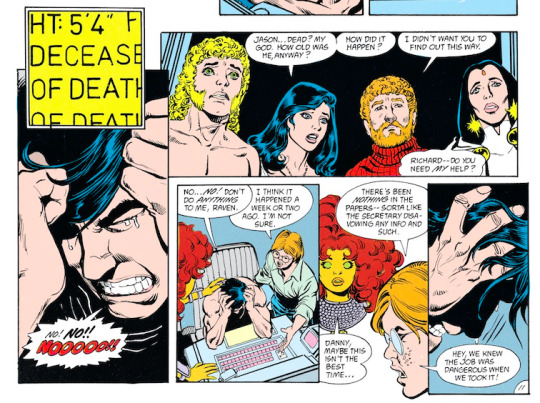
New Titans #55 (1989)
There’s a substantial difference between the two heights, and I think it’s also worth noting that for a 15 year old American male, 4’6 is in the 0.1 height percentile. In the past, I and many others have tried to justify that height along the lines of Jason being malnourished or similarly afflicted. Personally, I liked the parallel between this height for Jason and Damian’s height at his own death in 2013, and I know I’ve talked about that in the past.
I’m not criticizing anyone for using the 4’6 number, but I do think the unlikelihood of a 15 year old that size is worth bringing up.
In summary, The Batman Files (2011) is so bad of a source that I’m only willing to use it as a last resort. Unfortunately, it’s time for a last resort.
I mentioned a timeline in Batman Annual #25 (2006) that counts forward from Jason’s death. I’m not going to use image cites here because they’re just isolated text boxes labeled either “six months later” or “one year later.”
Using that timeline, we know that Jason’s resurrection took place six months after his death. He spent one year in a coma, then one year on the street, then one year with the League of Assassins. Finally, he spent a nebulous time training before he returned to Gotham.
We know that Jason was gone for a minimum of three and a half years, then whatever time “training” includes. Personally, I’m applying my best attempt at comic logic to say he was missing for somewhere between three and four years.
To understand the next bit, I need to point out that from Jason’s death on, I’m going to be using Tim’s age to track time in the same way I’ve been using Dick’s so far.
As a reminder, I know what age Bruce was when Dick became Robin (28), and I know Dick’s age at the same point (13), so I know there’s a 15 year age difference. As I track Dick’s age through the timeline, I add 15 to get Bruce’s.
In the same way, I know what age Dick was when Jason became Robin (19), and I know Jason’s age at the same point (12), so I know there’s a 7 year age difference. I can use that number ongoing.
I know that Tim was 13 when he made his first appearance as Robin, and I’ll get into that in the next section. After that, I’m placing Dick, Tim, and Cass’s adoptions based on Tim’s age.
To do that, I need to know how much older Dick is than Tim, and I can only get that by knowing Jason’s age at his death, sort of.
How long was Jason Robin? If I had that information, I could establish Jason’s age by counting up from 12, the age when he became Robin, then establish Tim’s age from there.
I can’t really answer that question. There is a panel from Batman #436 where Dick, apparently in his first time at the manor since Jason’s death says the following.
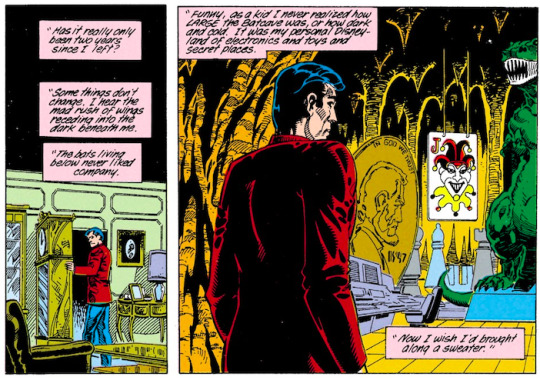
Batman #436 (1989)
My instinctual interpretation is it’s been two years since he stopped being Robin at 19, making Dick 21 and Jason 14. In my opinion, that’s straightforward plain language, but it seems like I’m in the minority on that one, and most folks read it as Dick saying it’s been two years since he was last at the manor. We know from Batman #416 (1988) that Dick’s last visit to the manor was 18 months after Dick left home.
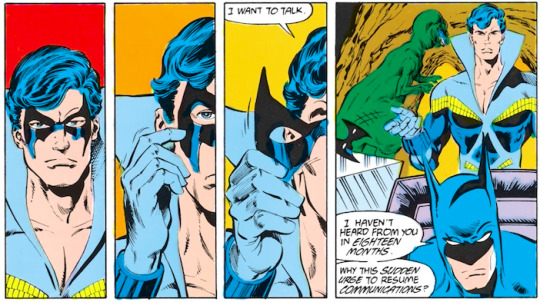
Batman #136 (1988)
I think the most honest thing to say is that Jason was Robin for an indeterminate amount of time that was somewhere between two and three years. I don’t know which number is closer. I also, if you remember, think that Jason was gone from Gotham for somewhere between three and four years, but I don’t know where in that range the real number is.
Here’s why absolutely nothing I’ve said in the past seven pages matters: I need to build my timeline based on the age gap between Jason and Tim.
I don’t know how old Tim was when Jason died.
I know how old Tim was at his first appearance as Robin, and that’s a different number.
We’ll finish this conversation in a moment.
----------
Tim becomes Robin
We begin, thankfully, with a straightforward fact. Tim’s first storyline spans Batman #440-442 (1989). The arc is called A Lonely Place of Dying, and we already talked about it. Tim, having watched Batman and Robin from the shadows for years, comes forwards in the aftermath of Jason’s death in an attempt to convince Dick to become Robin for a second time.
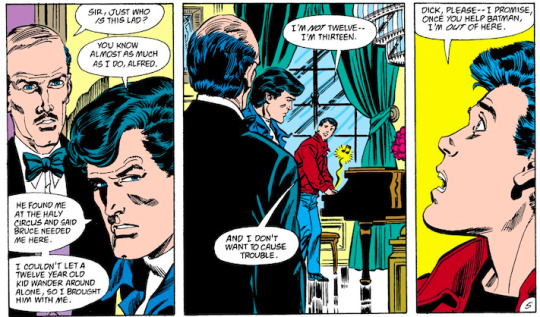
Batman #441 (1989)
We know that Tim was 13 years old at the time, but I do need to clarify exactly what time that was— an indeterminate amount of time after Jason’s death.
The word that pops up a couple of time in Tim’s first arc is “months,” from Tim and Two-Face. How many months? Who’s to say.
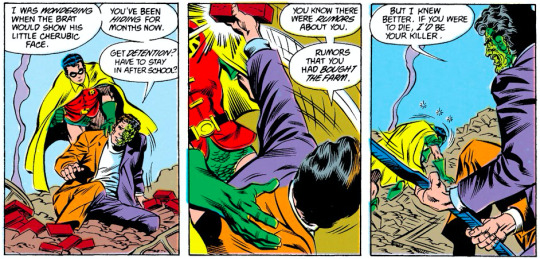
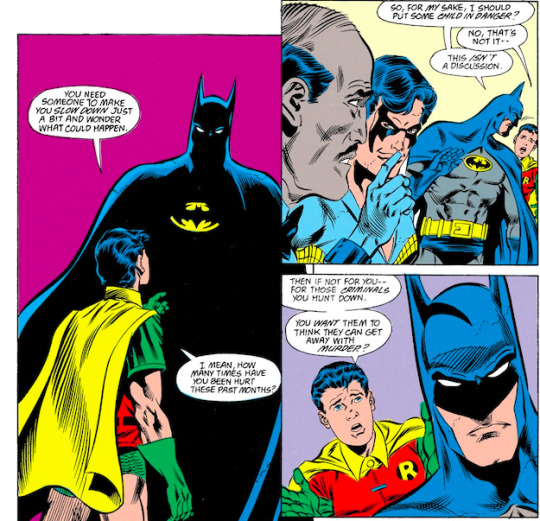
Batman #442 (1989)
So, from the top. We know that Bruce was eight when his parents died, 26 when he became Batman, 27 when he met Dick, 28 when Dick became Robin, and 34 when he met Jason.
Dick was 12 when he met Bruce, 13 when he became Robin, 19 when he left home and Jason became Robin.
Jason was 12 when he became Robin.
Bruce is 15 years older than Dick. Bruce is 22 years older than Jason.
Dick is 7 years older than Jason.
How long was Jason Robin? Unknown, but somewhere between two and three years. At that point, he died. “Months” after that, Tim was 13.
Here, we need to acknowledge that Jason could have been either 14 or 15 at his death, and at the same time, Tim was either 12 or 13. We need to know how far they are apart to calculate Tim’s age in relation to Jason, Dick, and Bruce— ongoing, we will always know exactly how old Tim is, so (if we know how far apart Jason and Tim are) we will always know Bruce, Dick, and Jason’s age from there.
How much older than Tim is Jason? Somewhere between one and three years, I guess, but I can’t really go beyond a well-researched guess. In my opinion, there isn’t a straightforward answer for this one.
Having presented my facts, here is my conclusion. Jason was 15 when he died. At the same time, Tim was 13. They are two years apart.
Why? To begin, I’m more comfortable using the number we already have for Tim, 13, than I am dropping him to 12 on the mere possibility that he could have been 12.
Second, even though The Batman Files (2011) is a terrible source, it does at least sort of indicate that the official DC position is a Jason who was 15 years old at his death.
Third, visually speaking, Jason looks closer to 15 than 14 at his death. Is that good evidence? No, absolutely not. Comic book art is definitionally variable, but I am going to pull a few panels for you to look over.
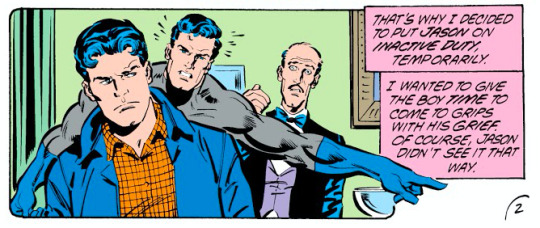

Batman #427 (1988)
Finally, I feel that Jason and Tim are, in later works, treated as if they are different ages. I’m not going to go into much detail on that one because it is purely a personal reaction, but I would refer to Teen Titans #29 (2005) as an example. That issue has Jason and Tim’s first meeting, after Jason comes to the tower specifically to attack Tim.
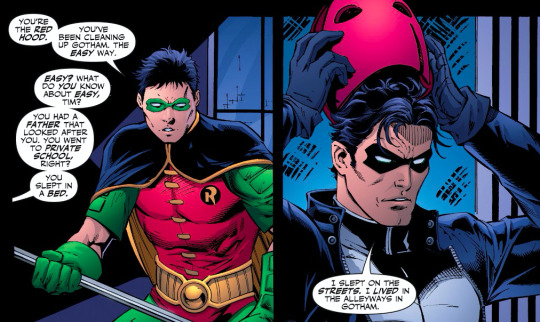
Teen Titans #27 (2005)
Another well-known issue to check out is Teen Titans #47 (2007).
My basic position is that there are so many ways, all uncertain, to slice Jason and Tim’s ages that I can take my pick. I chose the ones that most closely mirror later canon, fall most squarely into the possible range, and feel the most intuitively right.
They also have the benefit of simplicity, which was very much a factor.
Don’t agree with me? Fair enough. I think I’ve given you enough information to make an educated judgment, and I’ve also gone ahead and made a timeline in the alternative. In this one, Jason was 14 at death, and he and Tim are only one year apart.
----------
In the Alternative
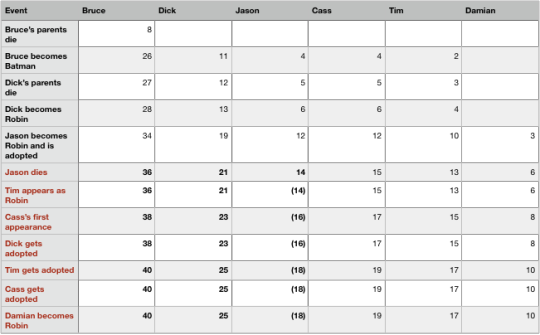
----------
Cass appears
Having progressed beyond Jason and Tim’s age gap, we reenter simple canon. I hope you’re as pleased as I am.
Cass was 17 years old at her first appearance, which we can establish easily based on two different issues. Cass first appears in Batman #567 (1999), during an arc called No Man’s Land. At the time, she is working for Barbara Gordon in the aftermath of an earthquake that destroyed most of Gotham. We learn Cass’s backstory through that issue.
Cass’s biological father is David Cain, a villain, who raised Cass in isolation, never exposing her to a verbal language or allowing any kind of socialization. By comic book logic, her upbringing gave her a near-superhuman ability to understand and anticipate physical actions, as those actions are her only form of communication.
Cain trained her as a child assassin, then took her to her first kill. Cass murdered a man and experienced, through his body language, the pain he felt at his death. Immediately afterward, she ran away from her father.
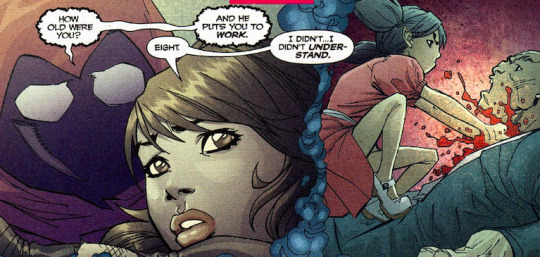
Batgirl #62 (2005)
We know that Cass was eight years old when she killed and ran. We also know that her first appearance in Gotham was nine years after she ran, thanks to Barbara Gordon’s file.

Batgirl #1 (2000)
Simple enough. She was 17. How old was everybody else? We find out from Tim’s timeline.
This next bit will come up a few times. We know that Tim was 15 from at least 1993 to 2003, established by three different issues. We know from Detective Comics #668 (1993) that Tim was 15 during Knightquest, the arc where Jean-Paul Valley was briefly Batman. Barbara tells us in 2002 that Tim is still 15, and Tim turns 16 on-panel in 2003.
In Knightquest, Tim gets his driver’s license early, at age 15, because Jack Drake is in a wheelchair. I suppose the wording here is ambiguous on a technicality, but I don’t think there’s any significant argument against Tim being 15; if he was only 14, the language would be different.

Detective Comics #668 (1993)
Next, in Batgirl #24 (2002), Barbara says she’s “sending a 15 year old” as she reaches for Tim’s com line.
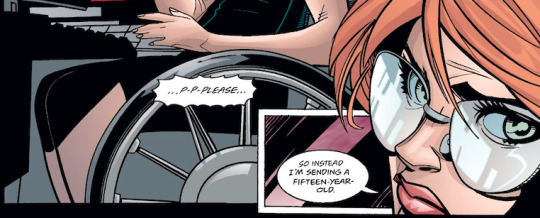
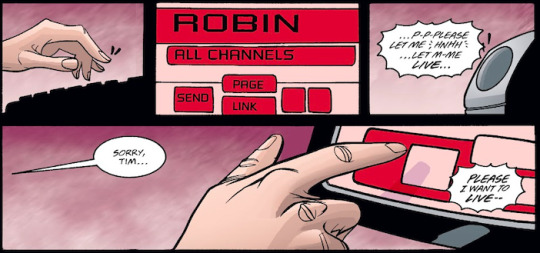
Batgirl #24 (2002)
We could stop here for Cassandra’s appearance, since that happened in 1999, between the 1993 issue and the 2002 reference. For completion’s sake, however, let’s note that Robin #116 (2003) is about Tim’s 16th birthday. He forgets about it, so his step-mother throws a surprise party.
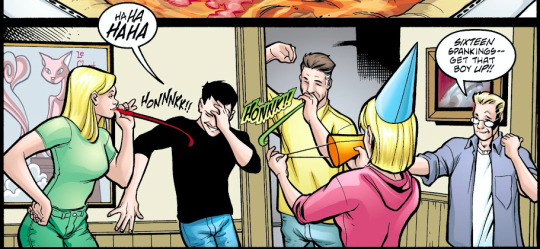
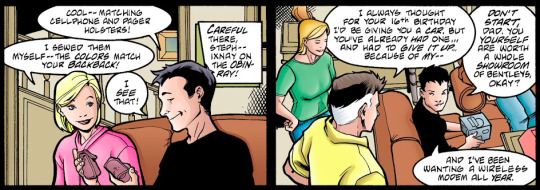
Robin #116 (2003)
Okay, so Tim was 15 when Cass appeared at age 17. That puts Bruce at 39, Dick at 24, and Jason at 17 if you’re counting by years elapsed since his birth.
Bruce met his daughter when he was 39 and she was 17, in reference to my original question. Cass is 22 years younger than Bruce, seven years younger than Dick, the same age as Jason, and two years older than Tim.
----------
Dick is adopted
This one, having already established Tim’s timeline, is very simple. Dick was adopted in Gotham Knights #17 (2001).
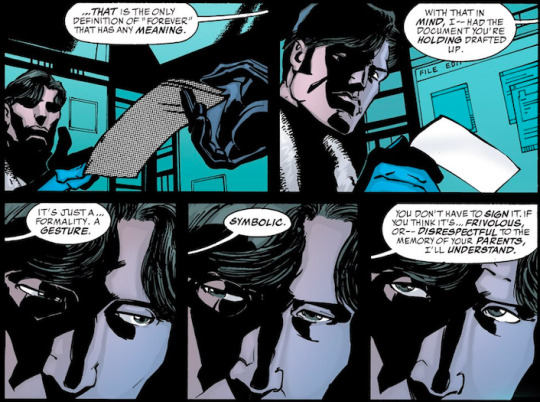
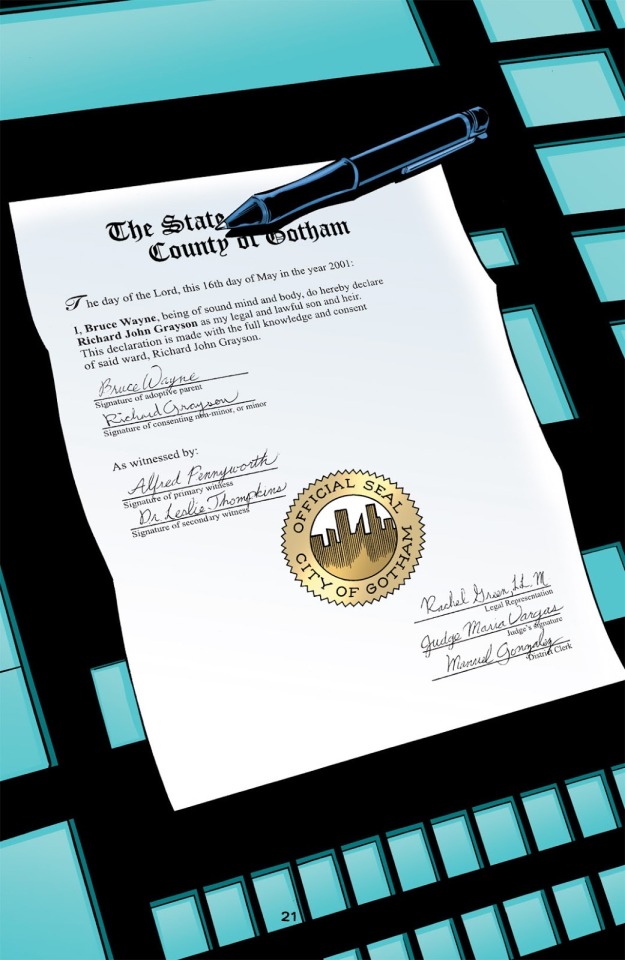
Gotham Knights #17 (2001)
Again, Tim was 15 from 1993 to 2003, and 2001 falls within that range. Tim was 15, which makes Dick 24 and Bruce 39.
At this point in the timeline, Bruce, a 39 year old, has two adopted children, one of whom is deceased as far as Bruce is concerned. His adopted children are (17) and 24. He has already met two of his future children, Cass and Tim.
----------
This is PART ONE. I’ll reblog Part Two onto this post when I wake up, which should be around the same time this posts.
#PART ONE of two#I'm going to reblog the last 10 pages onto this post as soon as it comes off the queue#timeline#mine#really lame that I can fit 50 pages into a post but then the last10 is too much
1K notes
·
View notes
Text
TOP TEN COMICS BOOK VILLAINS WE PROBABLY WON’T SEE IN THE MOVIES
Superhero media is the hottest thing going right now. It was true ten years ago when the MCU was in its adolescence, and it’s even truer now. Even with film production on lockdown, Marvel and DC are still planning on literally dozens of their characters entering their respective cinematic universes. However, for the fans of the source material, things can be contentious. For every memorable Tony Stark quip, there’s Superman destroying an entire city because he’s, frankly, kind of dumb now. A major point of contention is how the various popular villains are utilized. Making an intimidating and potent villain in a comic book is very different than in a film. In comics, you have months to establish motive, powers, and backstory before the villain even makes their first move. In films, that all has to be compressed and spilled out in the scarce few minutes when Captain America and Bucky aren’t making bambi eyes at each other. To be concise, some villains adapt perfectly, and some, no matter how good they are in the comics, just don’t. And to be clear, this list is of popular villains who have the possibility of appearing in a big-budget film, so no, you won’t be seeing Ten Eyed Man or Big Wheel in there. Their powers are, respectively, having ten eyes, and being very good in business. (That’s a lie, he’s just a huge wheel who chases Spider-Man.)
10: Mr. Mxyzptlk:
Cool, let’s get this one out of the way. Despite being one of Superman’s oldest, longest-lasting, and most popular enemies from all the way back in the Golden Age, there’s no way in hell he will be in a movie. For the uninformed. Mr. Mxyzptlk is a 5th dimensional wizard-genie who appears every ninety days to torment Superman with his reality-altering antics, and can only be sent back to his home dimension if Superman tricks him into saying his own name backwards. Yes, it would be very dazzling, as Mr. Mxyzptlk’s powers in a movie would basically look like if Christopher Nolan directed Who Framed Roger Rabbit, but he’s a little too silly to fit in with the current “everything is gloomy and also a bummer” tone of the Superman films. This silly tone has lent itself perfectly to the Supergirl series, where he’s made a handful of appearances. Besides, if we get Mxyzptlk in a Superman movie before Brainiac, I’ll lose my entire freaking mind.
9: Hobgoblin:
There have been eight Spider-Man movies so far, and of those eight, four of them have, in some capacity, featured the Green Goblin. And that makes sense, right? The Green Goblin is easily Spider-Man’s most memorable and reoccurring nemesis, with Doctor Octopus and Venom close behind, and Peter Parker’s link with Norman and Harry Osbourn makes their tragic story perfect for film adaptation. On the other hand, we have the Hobgoblin, who is essentially Green Goblin with all the gimmicks, none of the Parker-adjacent backstory, and an orange and blue color scheme, likely tying him to the Denver Broncos [citation needed]. Still, in those four cinematic attempts at tackling the Goblin, none of them have quite gotten him right, and I can’t imagine this character, who is, even in canon, an intentional Green Goblin rip-off, would fare any better.
8: Starro:
Brave and the Bold #28 from 1960 featured the first story with the Justice League, and this story put them up against a very unique new villain: Starro the Conqueror, a giant telepathic starfish who can release tiny versions of himself. If these tiny starfish latch onto your head, you’re under his control and obey his commands. The Justice League have battled him fairly regularly over the last fifty years, and he’s a distinct and powerful enemy that the fans generally appreciate, leading to him being referenced occasionally in Smallville, Arrow, and Flash. Why won’t he ever be in a movie? Because if you’re a Hollywood producer, you stopped paying attention at “giant telepathic starfish”. Sorry. Maybe Shuma-Gorath will pop up in the next Doctor Strange movie, and he’ll set off a Twilight-esque wave of starfish monster movies! Then again, almost absolutely not.
7: Puppet Master:
Speaking of mind control, what’s scarier than that? For my money, nothing. Having your body and will taken away from you by an unseen force is a terror greater than death. How could you possibly make a villain based around such a chilling concept and have him not be scary? Well, maybe if it’s an old bald man in an apron playing with dolls. The Puppet Master is an ongoing threat for the Fantastic Four who is just that: he makes models of his foes out of radioactive clay, and makes them punch themselves and dance around and kiss each other, because he’s, y’know, a weird old man. Why is he such a consistent threat who hasn’t fallen into obscurity like other dumb gimmick-based villains? His stepdaughter, Alicia Masters, is the Thing’s longtime girlfriend. As long as she keeps appearing in movies (including being played by… Kerry Washington? That can’t be right), there’s always a chance he’ll pop up, but I don’t think any movie studio is that stupid, despite the quality of every Fantastic Four movie blatantly defying that prediction.
6: Bizarro:
Superman has always suffered in the villains department. When you’re essentially a god, what can they throw at you? As it turns out, Lex Luthor, almost always. But why not another Superman? Bizarro is essentially that, an imperfect clone of Superman who speaks in opposite speak - “Bizarro am good! Me not punch you until you live!” - and features the same abilities as the Man of Steel. Sounds great, right? Putting a hero against a villain with their same powers has worked for nearly every Marvel movie (shots fired). So why won’t we see him grace our silver screens any time soon? Because they’ve never really figured him out. Is he funny? Is he lethal? Does Kryptonite work on him? If he does everything the opposite of Superman, why does he wear clothes? Isn’t being naked the opposite of being clothed? Bizarro is a major Superman side-character and has made appearances in Smallville and Supergirl, but the idea of him being the Big Bad going toe-to-toe with Henry Cavill doesn’t sound like it would generate a lot of views.
5: Impossible Man:
You remember what I said about Mr. Mxyzptlk? Remember? So take that bit, but everywhere I say Superman, have it say Fantastic Four instead… yeah, that should do it.
4: The Wrecking Crew:
Thor has a unique quirk of having a very cinematic rogues gallery. Sure, most of the movies have pitted him against Loki, but if they were to run him up against the Enchantress, or the Absorbing Man, or Ulik the Troll, or Kurse, or even the Stone Men from Saturn, that’s not a bad movie! However, in one of the attempts to give Thor more of a mortal nemesis, they put him up against the Wrecker, who has an… enchanted… indestructible… crowbar. Yeah. Incredibly, the Wrecker and his Wrecking Crew have become very present characters throughout the Marvel Universe, essentially serving as “jobbers”, being rolled out to get beaten up by the new top hero or villain, but that may not work in a movie, where villains have to be seen as having some level of potency before being struck down. That means we’d need at least a short scene where it seems like Thor might lose to a guy whose power is “crowbar”, and that’s about as likely as an Edward Norton cameo in the next Avengers. Ho boy, they did NOT part on good terms!
3: Clayface:
When the movie-going public goes to see a Batman movie, they generally want something a bit more grounded than your typical superhero fare. After all, Batman has no powers, and therefore the most supernatural thing that should happen in these movies is a gas that makes you smile, or a different gas that makes you think your dead parents are back and disappointed in you. Might wanna put a mouth covering on that mask, Bruce! The one and only they’ve made a movie where Batman fights people with real, off-the-wall super powers (Batman and Robin), it did not go great. And those guys pale in comparison to Clayface, who is, yes, made of clay. In the comics and cartoons, Clayface looks awesome, turning his limbs into weapons and being very challenging to incapacitate, but in a live-action, realistic Batman adventure, we wouldn’t want to see the Dark Knight fight a poop-colored version of the T-1000, especially if it’s got the same chemical composition of a little dreidel that I made.
2: Red Hood:
A relative newcomer to the Batman universe, Red Hood is the revived body of Jason Todd, the second Robin, who was brutally killed by the Joker in one of the most controversial storylines DC Comics ever produced. Literally, fans called a 900 number to tell the writers to kill him off. A 900 number. That’s how much they hated the little turd. Anyway, Jason Todd, whom Batman and the rest of the world believed was dead, was revived by Ra’s al Ghul and became a ruthless villain. Since then, he’s gravitated more to the side of the hero, though one a bit more willing to spill blood than his mentors. Why won’t we see him in the darker, edgier Batman films? Because… that’s Bucky. It’s the same thing that happened in Captain America: The Winter Soldier. Teen sidekick killed in controversial manner, revived by super villain to be a thorn in said hero’s side, later changes his mind and becomes a good guy again, though with enough PTSD to fill a PTSD super store. The two storylines even occurred in the comics in the same year, 2005, to much fanfare and across-the-board declarations of one company ripping off the other, reminding the world of the great Aquaman-Namor debates of the 1940s. Considering that DC’s films have criminally underperformed compared to Marvel’s, the last thing they want to do is be accused of lazy plagiarism, so Jason Todd will likely remain a permanent fixture in the afterlife, hanging out with Batman’s parents and, at the rate that people are coming back from the dead, literally no one else. (Plus, if they can’t even get Robin right, how are they gonna do this?)
1: Mister Sinister:
Yes, he was teased at the end of X-Men Apocalypse, but ignoring that the film underperformed both critically and commercially, Mister Sinister is never going to be in a movie. It would make sense for him to appear, though, right? He’s one of the most present and potent X-Men villains, he’s played crucial roles in many memorable storylines, he’s got a sick cape, but… something a lot of comic book fans tend to overlook is his murky backstory, powers, and motivations. He was a biologist in Victorian London who did genetic experiments on homeless people in the hopes of finding clues about the oncoming threat of mutants. In this time, he unearthed the long-dormant En Sabah Nur, whom you plebeians may know as Apocalypse, and Apocalypse gifted him with great abilities. What abilities you ask? HA HA, good question! At various times, Sinister has displayed: telepathy, telekinesis, energy projection, shape-shifting, regeneration, and teleportation, but these powers will mysteriously disappear whenever they want him to get sliced up real good by Wolverine. Additionally, it has never been made very clear what Sinister wants. Does he seek perfect mastery of the human genome? Does he live to torment Cyclops? Is he a blind follower of Apocalypse? Is he just running through all the different kinds of goatee? Of course, in adaptation, the writers would pick and choose the aspects they’d want to use, but I doubt they’d want to untangle the Christmas lights mess that is Mister Sinister, especially when they’ve got a perfectly good villain whose power is just “magnets”.
23 notes
·
View notes
Text
Batwoman Could’ve Been the PERFECT Batfamily Show
After Gotham ended so recently, Batwoman should've positioned itself as the Ying to that show's Yang by focusing on Batman's allies instead of his enemies.
The 'Bruce disappears hook is a brilliant way to do this
Kate is our audience entry point into this world
ORACLE + GORDON
Barbra Gordon has already been paralysed via The Killing Joke, and hasn't yet become Oracle - she's still recovering
Comissioner Gordon took an early retirement after his daughter was paralysed, which is why Kate's Dad's private security force the Crows runs the streets
Batwoman and the series' events inspire him to return and reclaim Gotham for the Law by the end of season 1
TIM DRAKE + WE ARE ROBIN
Robin disappeared with Batman, so we can introduce the We Are Robin gang. At the beginning of the season they're just criminals, but after Kate defeats their ringleader she shows them a better outlet for their rage, and inspires them. Duke Thomas (future Signal) is among them
Once the we Are Robins are established Tim Drake returns to Gotham. Kate is surprised - few people outside of Gotham know there have been multiple Robins. This way we can explain the different versions to people not in the know
Just like after Bruce was sent back in time in the comics, Tim has gone travelling the world as Red Robin, searching for him. Tim heard about the Robins causing civil unrest and is concerned about them marring Robin's good name.
Tim and Kate clash over the Robins' chaotic, violent modus oprendi - Tim enforces a philosophy of Robin as the light to Batman's dark - promoting positivity, not violence. A loose adaptation of the Robin War storyline follows where Duke Thomas emerges as the Robins' leader and rallies them to be more controlled and less violent
Tim leaves after this mini-arc, satisfied Gotham is in good hands. He also teaches Kate more about the detective side of Batman - he isn't just a blunt instrument. Tim will be our primary link to the 'Bruce's location' mystery throughout the series
NIGHTWING
Dick arrives in Gotham on a case from Bludhaven. Kate thinks he's abandoned Gotham - he should've taken up the mantle while Bruce was gone.
Explore Dick's troubled history with Bruce (not to F**k Batman levels), how Babs being Batgirl caused him to quit, and the one-two punch of Jason Todd's death and Barbra's paralysis only validated his getting out while he could
Tender scenes between Dick and Babs alluding to thier teenage crushes on each other.
As a cop, Dick hates the Crows being on Gotham's streets and more actively conflicts with Kate's father, driving up the tension between them and Batwoman
RED HOOD
This arc would be like a finale-style thing
Jason Todd returns and starts assassinating criminals with the ambition of 'controlling' crime. Kate is a soldier, more brutal than Bruce, so she has greater sympathy for Jay's methods
Jay is after the Joker. Like in The Dark Knight Returns, the Joker has 'retired' to Arkham since Batman left - he got bored pretty quickly. This arc introduces him properly after a few teases earlier in the series.
Jay learns of Barbra's paralysis (which happened after he died) - even then Bruce wouldn't kill him. A scene where Jason visits Babs (little brother/big sister dynamic).
Both Dick and Tim return for this arc, losing their shit over the Joker. Kate's reaction to the Joker is much like Terry McGuiness's in Batman Beyond: Return of the Joker. She doesn't get why everyone is so scared of this stupid clown.
Tim is the one who figures out how Jason was resurrected; just like in the Red robin comic he's been travelling through the world of assassins and knows about the Lazarus Pit.
I think doing the Red Hood arc without Bruce - the main target of Jason's anger - is super interesting. Most people share his anger at Bruce for disappearing.
It also lets us dig deep into the inter-Robin dynamics - Jason hates Dick because he always had to live up to him (do that thing in the comics where Jay had to dye his red hair black to 'look like Robin')
Jay hates Tim for replacing him, for being proof Bruce didn't learn his lesson, for Bruce treating Tim better, the way he should've treated Jason
Kate is instrumental to this arc because, being outside all the drama, she has objectivity. She forces Dick and Tim to get their heads out of their asses and talk to Jason, forces them to confront the problem.
Instead of taking the Joker to Bruce as he does in the Under the Red Hood movie, Jason takes Joker to Babs, who has suffered the most because of him. Confronted with the man who 'ruined' her life, Babs proves bigger and stronger than him. She refuses to kill him. Unlike Jason, she's moving on and growing past her trauma, not looking for revenge.
Joker (being the Joker) turns the tables on Jay and has him at his mercy. Kate swoops in and, like Terry in Return of the Joker, messes with the Joker's head by refusing to take him seriously. The Joker is distracted, screaming about Kate not being Batman, and Babs gets to knock him the fuck out.
Jason escapes, but not before dropping a clue connecting Bruce's disappearance to the League of Assassins
I know the showrunners admitted they have no clue where Bruce is yet, so in my version he's off on some quest with Ras Al Guhl. In the time since he's been gone he's married Talia and had a kid. no-one in Gotham knows this yet.
VILLAINS
We can explore how Batman’s absence has had a strange effect on Gotham's villains - many have gone into states of hibernation similar to the Joker.
Two Face gets his dark Knight Returns plotline where the attempt to repair his face,
Mr Freeze has a similar ‘cure’ story a la Batman Beyond
Clayface (as in the Rebirth run of Detective Comics) is trying to go straight - using his shape-shifting gift to make a name for himself in the movie business. He thinks he's finally been accepted, but people are just sucking up to him because of his talent - the reality of their disgust threatens to push him back over the edge
Without Batman there to fight her, Poison Ivy has pretty much taken over Gotham's main park space, but a kind of stalemate has been reached - she won't attack the city as long as the city doesn't move against her plants.
Kate's central dilemma is navigating these unusual waters - she toys with the idea of putting Ivy behind bars and we get an episode of her exploring the micro-climate of the transformed Park. Kate's disturbance makes Ivy threaten the city, and she has to stretch her underused negotiation muscles to talk her down.
I like the idea of Ivy as an ambivalent character, not good or evil. She'll do whatever she wants. Also she and Kate would have killer sexual chemistry.
Harley. Exploring Harley in such a strongly feminist show would be fascinating. Joker has closed off, given himself up. Harley is forced to fend without him, and finds an antihero niche with the Gotham City Sirens (hi, Ivy!)
With Bruce's disappearance, Wayne enterprises is designing revolutionary new weapons for the Crows. It's revealed that they’re using the Riddler to design these. After Batman disappeared it was presumed Nygma went through therapy and was moved away from Gotham - in fact he's here.
This plot point is inspired by the New 52's Zero Year arc. Kate discovers the foul play when the Crow's systems go haywire because of a virus Nygma planted, sending Gotham into a blackout and giving the Riddler control of its municipal systems
Kate finds Nygma and exposes Wayne Enterprises' corruption, but in the process Riddler escapes.
Similar to Ivy, Kate's appearance excites the Riddler and he reactivates his Saw-like trap rooms across the city. Kate has a different, much blunter way of solving puzzles that frustrates him, used to Bruce's genius-level intellect.
This raises the question - is Batwoman a liability to the city?
BATGIRL(S)/BIRDS OF PREY
With Riddler's re-emergence triggers the appearance of Spoiler. In the comics Stephanie Brown is Cluemaster's daughter, but no-one really gives a shit about him. The benefit of a decade-plus old Batman means his rogues gallery can easily have kids - Stephanie had her name changed in witness protection.
Steph helps Kate beat the Riddler in collaboration with Bab's hacking skills. Kate sees potential in Spoiler and sends her to Babs to be trained.
As Batwoman's appearance reawakens super-crime in Gotham, the Crows get desperate. They hire world- renowned assassin David Cain to start taking out targets
Intro Cassandra Cain.
Cass + Steph + Babs are this series' version of the Birds of Prey
Babs teaches Cass sign-language to communicate. Steal her friendship with Clayface from the Rebirth Detective Comics - Clayface leaves the movie business again because it was unhealthy, and is trying to do good
Everyone is very protective of Cass and determined she won't fight
#batman#batwoman#robin#Red Robin#nightwing#batgirl#oracle#kate kane#barbra gordon#dick grayson#Tim Drake#Jason Todd#batfamily#BatFam#batfam headcanons#cw#arrowverse#gotham#Stephanie Brown#cassandra cain#dc#dctv#we are robin#duke thomas#Under The Red Hood#the killing joke#birds of prey#zero year#dc rebirth
535 notes
·
View notes
Text
Zack Snyder’s Justice League: Joker Epilogue Explained
https://ift.tt/3cJN90s
This Zack Snyder’s Justice League article contains spoilers.
Despite the heroes’ best efforts throughout the four-hour epic, Zack Snyder’s Justice League still ends in scorched earth, with Darkseid’s forces decimating whatever’s left of the planet’s surface, turning it into a wasteland. Even after defeating Steppenwolf and preventing the disaster of Unity, it’s still not enough to stop what’s been coming to Snyder’s version of the DCEU since Bruce had his first “Knightmare” in Batman v Superman: Dawn of Justice. Or so it seems in an almost 10-minute-long epilogue, which includes a cameo from Jared Leto’s Joker especially shot for the Snyder Cut.
Joker’s inclusion in the movie might seem jarring to some, considering he has no bearing on the actual story being told for most of the film’s runtime. In fact, you could pretty much skip the epilogue completely and not lose much of the experience if you’re only watching for the main plot. That said, the tense conversation between Batman and Joker — as they look upon what Darkseid’s wrought on their planet — does raise some interesting questions as to what might be next for these archnemeses were Snyder to get yet another shot at the DCEU.
Ironically, Snyder actually shot the brand-new footage for Leto specifically because he thought he’d never get another chance to work with these characters. The director “couldn’t leave this universe without having a Joker/Batman scene,” according to producer Deborah Snyder in an interview with CBR. But shooting the scene in the middle of a pandemic was tricky: it involved sending a truck full of costumes to Leto’s house, who would then try them on for the director during Zoom calls to see what worked. According to Deborah, “there was a lot of Zooming and photos and things like that, but so much thought went into creating the character.”
This might explain why the “Joker Christ” look — a version of the villain wearing a crown of thorns featured in a Vanity Fair article — didn’t actually appear in the movie. It was likely one of the costume ideas that were nixed before filming. Something similar happened with Leto’s now-infamous “We live in a society” line in one of the trailers for the Snyder Cut, which the director says was ad-libbed by Leto himself while filming the epilogue. As you now know, that line is nowhere to be found in the scene, either.
So, what did make it into the epilogue? How did Snyder use his final chance to have these versions of Batman and Joker meet in a DCEU movie?
The Batman/Joker History
cnx.cmd.push(function() { cnx({ playerId: "106e33c0-3911-473c-b599-b1426db57530", }).render("0270c398a82f44f49c23c16122516796"); });
For one thing, Snyder touches on some very familiar elements of their dynamic. Like with past iterations of this relationship, Ben Affleck’s Dark Knight and Leto’s Joker are truly inseparable. Even when faced with the end of the world, when all bets are off and the rules no longer apply, the hero and the villain still decide to team up instead of settling the score once and for all. Joker is especially cognizant of their connection, mentioning how Batman created him and how his beloved Bat now needs him to undo what Darkseid did, even though it’s unclear just what the clown can do against such insurmountable, cosmic odds.
Bruce’s threat that he’ll eventually kill Joker is a particularly weak one when he’s also welcomed the Clown Prince of Crime onto his team, and equipped him with a bulletproof vest and an assault rifle no less. Their tense back and forth in this scene is just another section of their eternal dance, even as the Joker dares Batman to kill him. But if Bats were to give in to the temptation and end the clown’s life, who would be there to give him a reach–
Harley Quinn is Dead
We learn a few other things from their brief conversation (and one has to wonder why they’ve decided to do this in the open where they can be spotted by Darkseid’s parademons or Evil Superman): Harley Quinn has died in this possible future, but not before expressing her true hatred for Mr. J. Whether it was always the plan for Harley to break away from her insane beau in time for Birds of Prey or Snyder was trying to connect the dots after the fact is unclear. But her death is clearly a particularly sore spot for Joker, who for a second seems to want to break his own proposed truce and take a shot at the Batman.
“You’re good,” Joker finally says when he regains his cool, realizing the Dark Knight wants the clown to give him a reason to put him down for good. Self-defense ain’t the same as murder in the Snyderverse, right?
The Death of Robin
Robin’s death is finally addressed with one of the coldest lines in the entire epilogue: “I’m happy to discuss in any way you like, why you sent a Boy Wonder to do a man’s job?” the Joker asks Batman. This is in reference to a couple of things. The vandalized Robin suit displayed in the Batcave is a stark reminder of what is likely Bruce’s biggest failure in this universe, but we’ve never actually learned how the Boy Wonder died despite the references to the meteoric death sprinkled across Snyder’s earlier DCEU work. We know the clown did it but not how (perhaps for the best) or the events that led up to Robin’s death.
Read more
Movies
Zack Snyder’s Justice League Ending Explained: The Sequels and DCEU We Never Saw
By Mike Cecchini
Movies
Zack Snyder Wanted to Make a Batman vs. Joker Movie After Justice League
By Mike Cecchini
But that single line of dialogue delivered by the Joker suggests that some version of the 1988 comic book storyline “Death in the Family” has happened in this universe. In those comics, Robin (the second one, Jason Todd) goes off on his own to find his biological mother against Batman’s wishes, and instead comes face to face with the Joker, who murders him in extremely gruesome fashion. It’s a death that haunts Bruce as much as the deaths of his parents, which Leto’s Joker also references, along with Batman’s real name.
Batman Must Die
Most importantly, the epilogue seems to exist so that the Joker can plant a seed in Batman’s head: only his own self-sacrifice will be enough to stop Darkseid once and for all. This is a storyline that Snyder had planned to explore further in future Justice League sequels, a proposed trilogy that would have culminated with the Dark Knight’s death and the rise of a new Caped Crusader.
It’s unlikely that we’ll ever see this trilogy now that Snyder and the DCEU are parting ways, but the epilogue leaves the road clear for a sequel nonetheless, with Joker alluding to a time-travel plot that would involve Batman’s new crew going back in time to undo Lois Lane’s death and Superman’s villainous turn.
The DC Comics Inspirations
This is hardly the first time the Dark Knight and the Clown Prince of Crime have joined forces to fight a greater evil. Most recently, they’ve teamed up in the DC comics by Scott Snyder and Greg Capullo, particularly in Dark Nights: Metal and Last Knight on Earth, post-apocalyptic stories set in nightmarish wastelands that the director might have at least skimmed while writing this epilogue. In both of these stories, Joker is a key part of Batman’s ultimate victory. In Last Knight on Earth, Joker even finally become’s his “best friend”‘s sidekick.
But in terms of what inspired the grungier look of Justice League‘s Joker, it seems that the filmmaker and Leto went back to the Grant Morrison era of the character for inspiration. Just as Morrison and Tony Daniel’s “reborn” Joker was a clear influence on Leto’s get-up in Suicide Squad, the jarring butcher (?) costume worn by the clown in the epilogue might have been inspired by a similar look introduced in Morrison’s Batman and Robin series (above). Either way, it’s a very odd fashion choice when you’re about to go fight a New God, but then again, Joker isn’t exactly your average dresser.
With this Batman and Joker scene, Snyder reaffirms his love for these characters. Regardless of whether you find his take on their relationship worthy or not, it’s impossible to deny Snyder’s attention to detail when crafting his final DCEU scene, one full of references to Batman and the Joker’s past as well as their potential future. In his own divisive way, Snyder writes a love letter to these characters and goes out with a smile.
The post Zack Snyder’s Justice League: Joker Epilogue Explained appeared first on Den of Geek.
from Den of Geek https://ift.tt/2QlJ0bt
3 notes
·
View notes
Text
The Robin 80th Anniversary Special
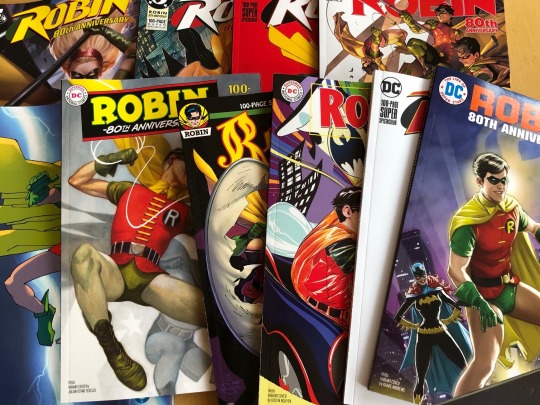
It's not a secret that I'm first and foremost a Dick Grayson fan, whether he comes dressed as Robin, Nightwing, Batman or something else. But I try to be charitable and be happy for fans of the other Robins that they got a pice of the birthday cake, i. e. the Robin 80th Anniversary Special.
For your enjoyment (?), here are my thoughts about the book. Spoilers ahead, obviously – don't like, don't read!
I honestly thought almost all of the stories were ok – but pretty forgettable. Marv Wolfman's spin on Dick leaving to become Nightwing, in "A little nudge" (art by Tom Grummett and Scott Hanna), is probably the only one I will remember and reference in the future. I don't know if or how it is supposed to fit into the (any?) continuity, but as far as I can see, it works nicely in the current setting.
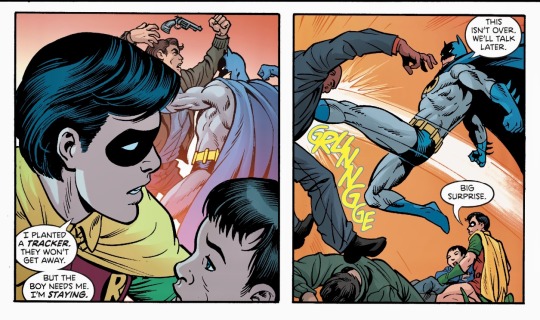
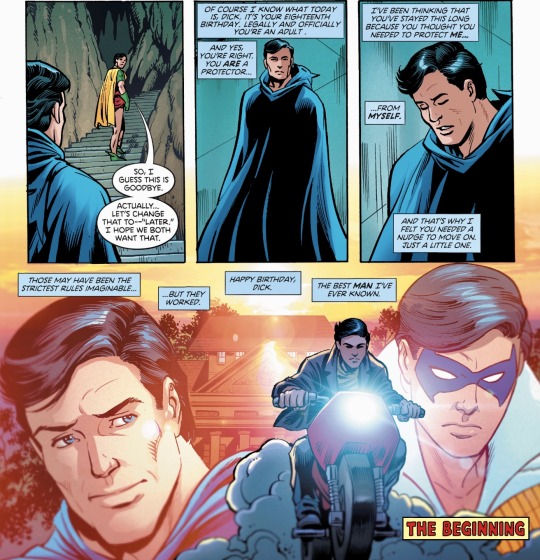
Dick's parting from Robin and Bruce was successively portrayed as more and more hostile. When he originally left Robin to become Nightwing (1983–1984), the two still had a good relationship. This changed in comics to, first, that Bruce decided to retire Robin, and then to that Bruce outright fired Dick and kicked him out of the cave. This lead to that their relationship was portrayed as poor, antagonistic even, for a good many comics years.
The bad mood was picked up by Batman The Animated Series, where Dick left being resentful of Bruce and his methods.
I don't have a lot of good things to say about what has happened to the Bat-family after Flashpoint. But from what we've seen from scattered panels, Dick was the one who decided he wanted to leave Robin. You can read Marv Wolfman's story as confirmation of that. Which is nice.
Bruce is only a little bit of a jerk in this story, being utterly rigid about that Robin has to follow orders. Dick, however, chooses to stay with a kid that had been shot instead of following the criminals.
Dick has had it with Bruce's rules and leaves the cave, but he says "later" rather than "goodbye".
It's made clear that those strict rules were Bruce's way to say, "I know you've grown up, and you should move on; I'll be fine without you."
Batman # 408, where Bruce decides to retire Robin because he got scared when the Joker shot Dick, is firmly established in my mind as the "correct" leaving story in my mind. It was the only one I had read and knew of for many years, and the two still part on decent terms. But Marv Wolfman's 80th Anniversary version has a lot going for it.
On to the rest of the stories...
"Aftershocks" By Chuck Dixon, art Scott McDaniel and Rob Hunter.

Set during Cataclysm (a storyline from 1998) where Dick lived in Blüdhaven before he moved back to Gotham and became Batman. It's an action-filled story where (fingerstripe) Nightwing comes to Gotham after an earthquake has hit the city.
It's interesting to read this, living through the corona crisis that is going on right now. I don't know how it is where you live, but where I am, people are setting up networks to help people who can't go out to shop or walk the dog, University students are helping kids do their math lessons with the help of Facebook, people make masks for health workers etc. But when Chuck Dixon writes what happens after a catastrophe, Dick has to fight his way through masked thugs who are trying to rob an ambulance of "painkillers and tranks" when he tries to save a cab from falling with a damaged bridge. A woman is giving birth inside the car, and the story ends with that the mother wants to name the boy after Nightwing.
"Well...Robin works, right", he says.
"Team building" by Devin Grayson, art Dan Jurgens and Norm Rapund.

Well, I'll always soak up everything that has to do with Dick and the Titans – Teen Titans, New Teen Titans, Titans, any Titans...
Devin Grayson wrote The Titans 1999–2000, which is the setting of this story. Most of it takes place inside a H.I.V.E. locale, where an exasperated boss (Damien Darkh) chews out his soldiers after a fight with the Titans. But Darkh decides not to kill the lot of them, because they did distract the Titans while he stole a red crystal/power source. Of course, it turns out Dick is the soldier who has kept his helmet on; he takes the crystal with him and gives Darkh a bit of advice on team-building on his way out.
"Generally speaking, fear of execution isn't a great motivator. I've found basic team-building and morale-boosting to be much more effective. Like, I'm just spitballing here, but... You ever consider a pizza night?"
Well, it did keep me amused, and it shows us that Dick is a good leader and strategist, (and a great acrobat who manages to get out of the H.I.V.E. uniform with one hand, on the way out), although it isn't exactly a surprise that Dick was in the building when you get near the end.
"The Lesson Plan" by Tom King and Tim Seeley, art Mikel Janín.

Now, I do like some things about the Grayson run, but with a bit of distance, I've realized it was mostly the art. The sexualization of Dick and how King and Seely wrote him as a guy who jumps first and plans never got tiresome. This story is in-character for Grayson; Dick is accompanied by a girl (Paris) from St Hadrian's on a mission, and on the way, he remembers the lessons Batman gave him and imparts his own interpretation of them to Paris. As is Batman says, "plan everything", and Dick says "Improvise. Leap first... figure it all out on the way down." Ergo, classic King and Seeley. Also, it is possibly implied Dick made out with a beautiful girl that turned out to be gorilla in disguise...? Yep, vintage King and Seeley.
Other than that, I don't have a big problem with the story. Some things ring true to me – as when Dick remembers Batman saying, "At their core, people are cowardly and self-serving. Trust no one until you know them. And even then, never completely". And what Dick says is, "Give the benefit of the doubt until you gotta knock 'em out."
For my own peace of mind, I'm reading this as Dick is half-joking with his advice. It's not like we've never seen him make plans and be suspicious post-Flashpoint.
On a side note, one of the best characterizations of Dick Grayson to my mind is a panel from Black Mirror. When Dick explains he had injected James Gordon Jr with a subdermal tracer, and says about himself, "I am a softie. And I do try to see the best in people... but that doesn't mean I'm stupid."
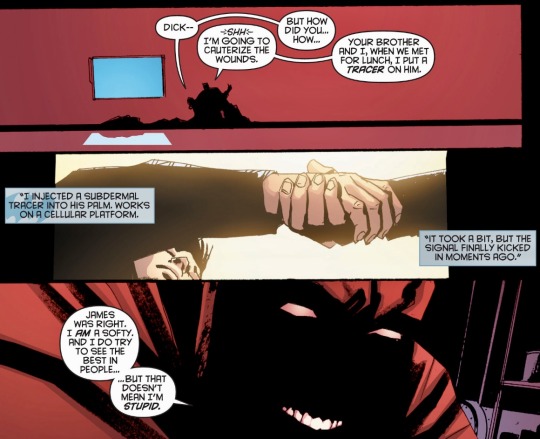
Detective Comics # 881. By Scott Snyder, art Jock and Francesco Francavilla.
"More Time" by Judd Winnick, art Dustin Nguyen.
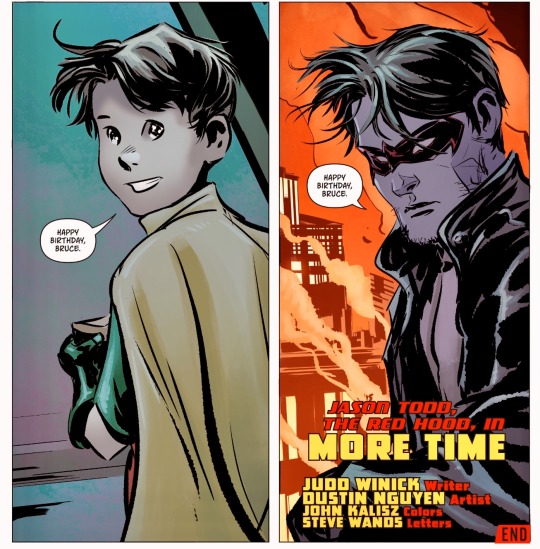
Jason has a cute story about him repairing Thomas Wayne's watch as a present to Bruce. He started the work as a tiny Robin (too tiny, in my opinion, but with Dustin Nguyen on art it probably couldn't turn out any other way) and finished the work as Red Hood. Jason delivers the present to Bruce on his birthday, placing it on the Batmobile while it is parked in a Gotham alley.
"Extra Credit" by Adam Beechen, art Freddie E. Williams II.
Tim has an appointment with the guidance counsellor at Gotham City High School. Tim sees a future in law enforcement (that's the first I've heard of that, but I'm no expert on Tim) and he's adopted (again, something I haven't seen post-Flashpoint). But the counsellor doubts that Tim will be admitted because he has nothing to show when it comes to extracurricular activities. It's kind of a fun few pages where the counsellor suggests things that Tim could do, and Tim thinks about what he does as Robin on his spare time.
"Boy Wonders" by James Tynion IV, art Javier Fernandez.
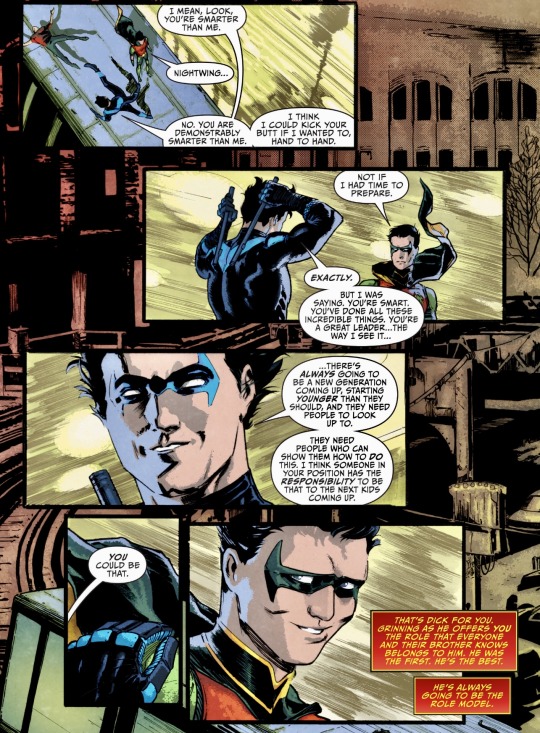
Tim, Red Robin, is unsure what he wants to do with his life and goes to his brothers? fellow Robins? for advice.
I know emotions have been running high because Dick tells Tim that he is "demonstrably smarter" than he is, which makes it sound as if Dick is not really smart at all.
Again, for my peace of mind, I choose to read this as I want: that "big brother" Dick is encouraging, he has always thought highly of Tim, he has no ego to preserve. This doesn't make Dick a reliable narrator on the subject, and the page ends with that Tim thinks "He was the first. He's the best. He's always going to be the role model. "So, two brothers who admire each other.
Tim also talks to Jason and Tim, and the story ends with that he tells Batman he wants to start Gotham Knights protocol, the team in Detective Comics (Rebirth.) 2016-2018.
"Fitting In" by Amy Wolfram, art Damion Scott.

Stephanie, as Robin has problems because Tim's Robin suit doesn't fit her female body. But at the end of the day, Bruce gives Stephanie her own "changing room" in the Bat-cave, because she's female.
...are Bruce and Alfred idiots? Did Dick, Jason and Tim have exactly the same body type when they were Robin? Stephanie deserved a story worth being told, not this one.
"My Best Friend" by Peter J. Tomasi, art Jorge Jimenez.
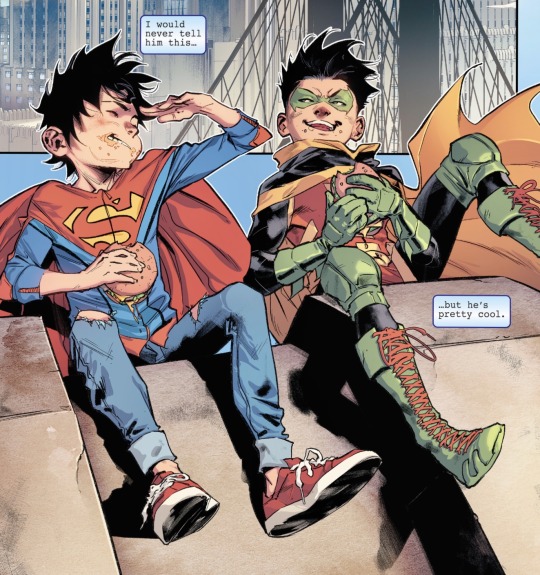
Jonathan Kent writes a school essay about his best friend, Damian. As he writes the words on his laptop at home, they are illustrated with pcitures of the two as both Robin and Superboy, and as Damian and Jon in civvies. Tomasi and Jimenez worked with Super Sons (2017–2019), and though I didn't read that, I'm pretty sure this story is an extra chapter in that series.
"Bat and Mouse" by Robbie Thompson, art Ramon Villalobos.
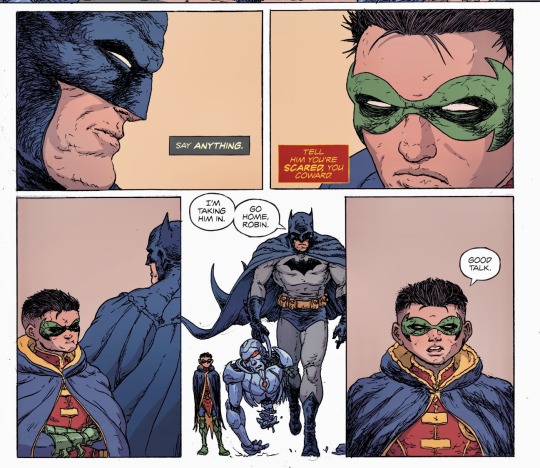
It's not the worst story in the book, but somehow the one I disliked the most. It is part of what is going on in Teen Titans and Bat-titles right now; we see Alfred's tombstone and how Batman and Robin have a strained relationship and difficulties in communicating. I'm not keeping up with what is going on with Damian and Bruce in detail, so I really can't say whether this story is consistent with how things have been going lately. I'll let Bruce-and-Damian fans take that ball.
To be honest, my reaction to "Bat and Mouse" is probably due to that I really, really don't like what's happened in the Bat titles lately. I firmly hope that the current situation will be changed and Alfred will be alive again, and I wish I could go back and re-read this book years from now without being reminded of this very dark time when DC seemingly doesn't want any money from me for new comics...
Being who I am, I probably take it waaaaay too seriously to try to understand where/if these stories fit in the DC continuity... The writers have probably (rightly) thought more about writing a good story than making it consistent with any grand plan for a timeline for all of the DC universe. But whatever.
The Grayson story clearly happens in a post-Flashpoint universe, as does Damian's and Tim's stories. But Tim says he's adopted, which I believe has never been said outright post-Flashpoint. And Stephanie has as far as I know not been Robin in this continuity. Chuck Dixon's Nightwing story is explicitly set during Cataclysm (a storyline from 1998) where Dick lived in Blüdhaven before he moved back to Gotham and became Batman. Post-Flashpoint, he moves to Blüdhaven for the first time in Nightwing vol 4., so Dixon's story should take place in the old continuity.
On the other hand. The last pages of the book are made to look like profile overviews in the Bat-computer and use pictures from different Robin runs. If the snippets of information are supposed to be the current continuity for the Robins, a lot from the pre-Flashpoint universe is back in canon.
Shortly, Dick was adopted (that's the word they use), formed the Teen Titans, moved to Blüdhaven and was Agent 37 for a while. Blüdhaven comes before Agent 37, but it's not explicitly stated when he first moved there. Because if Dick was in Blüdhaven before his time with Spyral, it is inconsistent with parts of Rebirth Nightwing. (Which I can live with...)
Jason's story starts as the street kid who tries to steal the tires of the Batmobile, his stint as Robin was short, and today, Red Hood has formed a tenuous alliance with Batman. Tim uncovered Batman's secret and made a bid to become the new Robin – and his new moniker "Drake" is acknowledged. Stephanie was Robin for a very short while. Damian was created with genetic material that Talia stole after a romantic tryst with Bruce, and he was bred to be an assassin.
Personally, of course, I think that Dick Grayson was worth more of an effort from DC on his 80th anniversary. But on the whole, the things we got were decent, "A little nudge" gave me something I will keep with me, and several of the covers are great.
(The cover photo is still pinched from Dan Jurgens' Twitter – I haven't bought all of the variant covers.)
60 notes
·
View notes
Text
CHARACTER META - PART 1. ( INSPIRATIONS )
So, I decided to turn this meta into two different parts. This first part, the “inspirations” part, is the part where I basically just list up all the most important quotes, scenes and overall storylines from other canon Joker stories outside of the telltale game, that I take inspiration from when it comes to my portrayal of John (note that when I say inspiration, I mainly mean that I look at what kind of mindset / person it takes to say and/or do these things, not that my John actually has done any of these things yet...)
The second part, which will be the “character study” part, will be in another post, and will be the post where I talk about how everything listed here plays into my portrayal of John, and basically try to explain as much as possible about John’s mindset / behavior / beliefs / etc, etc.
Anyways, this part is basically just for those who are interested to know just exactly what it is I’m looking at, and what I keep in mind while I try to flesh out John’s character beyond what just the telltale games did, because (as I will get more into in the second part of this meta, the John we see in the telltale games, and the John you mostly see in my interactions on here, is just a facade that he puts up, and not actually the real him.)
Either way, here’s the list of the most important things I draw inspiration from.
inspirations
THE DARK KNIGHT
“ Do I really seem like a guy with a plan? You know what I am? I’m a dog chasing cars. I wouldn’t know what to do with one if I caught it. I just do things.” - The Joker, about himself
“ I try to show the schemers how pathetic their attempts to control things really are.” - The Joker, about his “plan” so to speak
“ See, their morals, their code... It’s a bad joke. Dropped at the first sign of trouble.” - The Joker, about people in general
“ Some men aren't looking for anything logical, like money. They can't be bought, bullied, reasoned, or negotiated with. Some men just want to watch the world burn.” - Alfred, about the Joker.
We also have a few scenes in this movie I think is important to his character too. There’s the scene where the Joker laughs while being beaten by Batman in the GCPD interrogation room. There’s the scene where Batman is driving the Batcycle towards the Joker, and Joker, in turn, walks towards him, shooting at random cars driving by, while talking about wanting Batman to hit him. There’s the scene where he gets thrilled when Dent decides to flip his coin on whether or not he’ll shoot him in the head, and there’s the scene with the Joker laughing while he’s falling towards his death, before Batman saves him.
Every scene he comes up with a new backstory for how he got his scars, are also scenes that I find worth taking note of.
And of course the iconic scene of the Joker burning up basically a small mountain of money.
There’s also the scene at the very beginning, where the Joker comes up with a plan to rob a bank, except he executes it by telling some of his men, individually, to kill the others once their part of the job is finished, basically setting them all up to take out each other, until there’s only one left, who the Joker then proceed to kill, before driving off with all the money alone.
THE KILLING JOKE
Here, I think the storyline overall is a very important aspect of his character. For anyone unfamiliar with this comic, we see the Joker trying to prove his point to Batman, that everyone can go insane by just having one bad day. Though instead of targeting Batman directly, he decides to prove his point by targeting Jim Gordon. So the Joker and some of his men shows up at Gordon’s home, shoots his daughter, right in front of him, the bullet ending up paralyzing her. then the Joker proceeds to take Gordon with him and tries to mentally torture him to break him and make him go “insane” just to prove to Batman that he’s right.
There’s also a few quotes from this comic that I find important to his character.
“ Most repulsive of all are it’s frail and useless notions of order and sanity. If too much weight is placed upon them... they snap.” - The Joker, talking about people in general
“ Faced with the inescapable fact that human existence is mad, random and pointless, one in eight of them crack and go stark slavering buggo! Who can blame them? In a world as psychotic as this... any other response would be crazy!” - The Joker, about people in general
“ No. I’m sorry, but... No. It’s too late for that. Far too late.” - The Joker, after Batman offers to help him at the end of the comic.
BATMAN: ARKHAM ORIGINS
In the Arkham Origins game, I look at how the Joker is shown to be capable of pulling off making others believe he is Roman Sionis ( Black Mask ) by dressing up as him, imitating his voice, general mannerisms, behaving more “sane”, etc. I think it really shows an interesting aspect of his character that we don’t get to see a whole lot outside of telltale, which is that he is very talented at deception, acting, manipulation, etc, and that he’s not necessarily always blowing things up or killing people off left and right.
There’s also the scene where the Joker was ready to be shot by a bazooka by Bane, laughing excitedly as he’s blown off the building and falling towards his death before the Bat saves him (quite similar to near the end of the Dark Knight movie.) Then, after Batman saves him, he even puts a gun to his head, with every intention to pull the trigger, only to see if the Batman would save him again or not.
BATMAN: ARKHAM CITY
Here, it’s not so much the Joker’s quotes I take inspiration from, but more the various Joker thugs on the streets talking about him.
“ Today, however, we shoot ‘em. Yesterday we took 'em in the back room and burnt off their skin. But sometimes, Joker just lets anyone join. Keeps things interesting. [...] You’re just lucky you joined on a good day.” - The Joker’s men, talking about Joker’s way of “recruitment”
“ At least with the Joker, you know he’s got a plan.” - one of Joker’s men, arguing why he thinks it’s better to work for the Joker than Two-Face.
“ The Joker’s crazy.” - thug 1 “ At least he’s funny.” - thug 2 “ ‘til he kills ya.” - thug 3. - ( Joker’s men, discussing working for the Joker)
“ We do this for the Joker!” - Joker’s men, basically expressing their loyalty for the Joker, even when he’s sick and possibly dying.
There’s plenty more quotes like these, but you get the drift. Some of them aren’t so sure about working for the Joker, while others actually seem to like / prefer working for him.
There is also two scenes with the Joker that I find important in this game. First, the one where Harley approaches a tied up Batman, wanting to remove his mask, but the Joker stops her, because he doesn’t want Batman’s identity to be revealed as he thinks it would spoil the fun.
The second, which is more the overall storyline, is that the Joker wants a cure from the deadly disease he has, so he won’t die, showing that sometimes he actually doesn’t want to die / is worried about death.
BATMAN: ARKHAM KNIGHT.
In the Arkham Knight game, I take inspiration from the “flashback” scenes that Batman hallucinates / sees Joker’s memories, where the Joker physically and mentally tortures Jason Todd (a teenager at the time) for an extended period of time, and the flashback scene (and Killing Joke reference) of the Joker showing up at the Gordon’s house and shooting Barbara Gordon, paralyzing her, then taking photos of her to show her dad in an attempt to drive him insane.
I also draw inspiration from the generally really dark sense of humor he shows in this game, such as "joking” with Batman by saying that he can’t really save ALL of Barbara, as he (the Joker) killed half of her already, or after he shot Barbara, saying “oh, don’t pass out just yet. Show a little spine.” etc. You get the drift. Really dark “jokes” that aren’t really jokes at all.
BATMAN: THE ANIMATED SERIES
While I don’t draw a whole lot of inspiration from the animated series, I do think a few small scenes are kind of interesting that we don’t really see a whole lot of in other Joker canons, and that is that in certain moments, he actually does seem worried at the thought of dying. e.g. in the ‘Last Laugh’ episode where he’s dangling upside down over a pit of fire, a wire around his foot being the only thing between him and certain death, while he’s not terrified, or even straight up scared, he does seem mildly concerned at the thought of Batman not saving him. Or in the ‘Joker’s Favor’ episode, when Charlie threatens to blow them both up with Joker’s bomb, the Joker seems genuinely worried, scared even, at the thought of dying there with him. Even to the point of being relieved when Batman shows up, and then, when Charlie tosses the “bomb” at him (which turns out just to be a fake bomb.) he runs to take cover behind Batman.
I also notice in the animated series, that the Joker often pulls out dangerous toys / weapons a lot, which are usually in locations he’s familiar with / spends time around, for example one of Gotham’s abandoned carnivals, which suggests that he makes sure to have lots of getaways and back-up plans to get out of unexpected situations that may arise.
... There’s probably a whole lot more canon Joker stories that I also take inspiration from that I just can’t think of right now, but if I do think of something, I’ll update this list later. For now, I think this summarizes the most important things I look at pretty well, though. So, stay tuned for the second part of this meta, where I go into detail about how all this plays into my portrayal.
[ PART 2 ] - [ PART 3 LINK TBA ]
#long post for ts#♚. known issue. «character study.»#i have to make this into a two parter otherwise it'd have gotten SO LONG lol#literally this is just the list of what i take inspiration from. then it's like multiple paragraphs talking about john's actual character#which i'll probably work on for another few days before posting#but hey look i got the most exhausting part of this meta done. i guess that's something ;u;
3 notes
·
View notes
Text
I like giving really extended author’s notes (or ‘director’s commentary’ if you will) about my fics, but since AO3 is hardly the place for adding those, ehm, guess it’s gonna be bonus content for the tumblr crowd?
Now chapter 3 of No Shadow Falls is up, I just really want to ramble a bit about the thought process behind it. Do people give spoiler warnings for their own fics? If so, consider this it. Please read ch3 first, just in case :’)
So this is that UTRH/Court of Owls mashup fic I mentioned a while back! The premise I wanted to do was basically ‘What if the Court caught wind of Robin!Jason being led into a trap by the Joker & saw a chance to get a new Talon’. Combine this with a little of ‘what if Bruce never found Jason’s body but still presumed him dead bc of the explosion and copious amounts of blood at the scene etc (even though he secretly keeps looking for him still) à la Arkham Knight’ and voilà, here we are.
Considering the fact this fic’s setting is contemporary, I actually imagine Joker would’ve recorded video evidence of him beating up Jason to taunt Batman with too... Hmm, maybe I should re-label this a UTRH/CoO/Arkham Knight mashup instead...
Did I mention that if you’re here for romance, you better strap in for the long haul? Because this is gonna take a while, alright
Prologue
Can you tell I like being poetic? Or that I enjoy parallel & contrasting sentence structures?
first & last paragraphs (the ’beginning’ & ‘end’) include ‘a boy’ & ‘a bat’
‘how the story goes’ vs the later ‘NOT how this story goes’
second & second-to-last paragraphs both start with ‘you see’
3rd & 4th paragraph start with ‘maybe’
the structural halfway point is between the 3rd & 4th paragraph, so between ‘an end (death)’ & ‘a start (resurrection)’
in those same paragraphs: ‘in flame and fire with ice building in his gut’ versus ‘in liquid and ice with fire running through his veins’
Yes, the prologue is from Jason’s POV through his death and resurrection
Chapter 1
The working title for this chapter was ‘Something In The Water (...it’s bodies)’ though I changed the location the body was found in the end.
That stream of consciousness that serves as the intro paragraph(s) is supposed to reflect the opening narration of the Court of Owls storyline, wherein Bruce muses over the Gotham Gazette's 'Gotham is...' column.
Also let me tell you I knew from the start I wanted to do a UTRH retelling but with Talons, and I still somehow forgot Dick’s leg was in a brace during the original UTRH story until I went back to fact-check.
[announcer voice] All names of the victims/CoO members are purely made up, canon can bite me because I don’t care much for the turn the CoO story took after a while but that’s a rant for another day
‘Dick is getting precariously close to the end of his rope’, get it?? foreshadowing that the victim was gonna be found hung up under the bridge? eh?? I like to think I’m funny when I’m not
Chapter 2
I re-wrote this entire chapter from scratch (except for the last 'night’) because I hated the first draft so much
Guys, I love Babs-as-Oracle. Dunno if I can do her justice, but please know I love her.
I don’t think this detail matters if you don’t know much about comics canon: Tim and Cass did stay in Blüdhaven for a while in the past, but they’re mostly back in Gotham now. They still have a hideout in the Blüd and drop by to visit Dick/avoid Bruce every so often, and Cass also spends a lot of time with Babs (& Steph, again, I’ll mention her at some point. so many characters to juggle, christ. I’m gonna level with y’all, I just do NOT want to deal with the War Games storyline in this fic, so don’t expect me to reference it)
Talon did, in fact, use a crude version of Batman’s grapple hooks to get the body up on the bridge. Why display it in the first place? See ch3: as a provocation to both Batman and Nightwing in specific, because Jason is a dramatic lil’ shit no matter what universe you put him in
The Talons in canon seem to have more weapons that fit their fighting style, but I went for the combination of grappling line + (throwing) knives for now because Jason actually does use a knife in UTRH. I might make him use guns, at some point, but for now it’ll be the usual improvised bat-gadgets like flashbangs, smoke bombs etc, plus knives
And thus starts our story of Talon messing with Dick
Chapter 3
The ‘Such Terrible Hungers’ chapter title is taken from the same poem as the main story title (’No Shadow Falls’), namely, Louise Erdrich’s “The King of Owls”. For obvious reasons.
This chapter, I re-wrote about fifteen times. I wanted to cry in frustration.
Anyway, yay, more Jason POV! (in my weird quasi-poetic format)
[insert obligated identity crisis because he was forced into a role he never wanted but it’s now useful to his cause]
Points I want to single out:
Whenever I use text in italics+brackets, it’s some form of unbidden thought coming to Jason’s mind
Drinking game: spot the references to how Bruce failed to find Jason/the Owls (”a detective who cannot find what he is looking for“) or how nobody seems to want Jason bc he’s Jason, they just want him as a substitute for Dick
This is also why Talon doesn't want to be caught, he wants to be found. Small but significant difference
There’s an underlying theme of ‘stories’ in my quasi-poetic chapters, so I really wanted to incorporate the classic ‘Once upon a time, there was...’ ‘One day, ...’ structure of fairy tales/bedtime stories. Lest we forget the CoO also had a nursery rhyme dedicated to them
“Talon never spilled his secrets but oh, how the Owls would have laughed if they had known.” >>>> the Owls ovbs interrogated ‘Robin’ (Jason) while he was in captivity, but they didn’t get much info from him. I’ll mention the details in some later chapter!
Yes, I do the ‘Night-Wing’ ‘Gray-Son’ spelling thing on purpose to show that Jason’s mind isn’t all alright at this point
The switching between ‘the Gray Son’ & ‘Gray-Son’ is also on purpose to show the cracks in Jason’s conditioning/the Owls’ failure to brainwash him fully
I try to keep most of Jason’s core characteristics intact - his focus on victims + helping them, his disdain of Batman’s methods - but I’m going to have to change some bits to fit the Talon narrative I think. We’ll see how it works out...
That being said, he’s mostly gonna be messing with Dick because he’s petty and bitter, but it turns out to be more fun than he thought it would be. After all, our boy severly lacks human interaction & Dick is a relatively expressive person (the polar oposite of the Owls’ haughty/better-than-thou/distant demeanor & even Batman’s carefully controlled reactions)
Bonus scrapped story element: at one point I had the idea to have Talon be as good as mute because of a particularly brutal blow (from the crowbar) injuring his throat/vocal chords. I couldn’t think of a way to incorporate it on top of everything else though, so that remains an idea for another time...
(Seriously though, Jason and Cass silently bonding over speech issues, sign me up. Especially bc Jason loves literature and Cass is into theater it seems, you can do so much with that)
#eve.fic#i still haven't refered to Jason by his actual name in-fic but I assume all my readers figured out by now he's Talon#addendum: nsf#fic: nsf
6 notes
·
View notes
Text
Comic book readers today, especially young ones, will rightfully and righteously rage about the Captain Hydra America/Secret Empire storyline. They are correct to rage against Captain America being portrayed as a fascist dictator.
Then they turn around and play Injustice 2, a video fighting game in which Superman was driven mad by the Joker and then became a fascist dictator. And nobody has a problem because “it’s an alternate Earth” or “It’s just a video game.”
Either both of these are wrong, or neither one is.
As someone who read comics from 1989 to 2007, and still occasionally today, let me make this clear; comics went off the deep and a long time ago. Superior Spider Man is not okay. Unworthy Thor is not okay. Superman’s death is not okay. Bane breaking Batman’s back is not okay. Jason Todd being killed is not okay, and neither is him coming back form the dead as a Punisher wannabe. Terra being an irredeemable sociopath who brought the roof down on her own head is not okay. Gwen Stacy’s broken neck is not okay. Roy Harper sticking a needle in his arm is not okay. NONE OF IT IS OKAY.
And on those rare occasions when heroes are not being deconstructed/victimized in this way, they are being mocked and laughed at instead, a la Batman ‘66. Yes, I’m well aware it’s an adaption of the old tv show (RIP Adam West); I’m old enough to have watched it in reruns in the late 70s.
We’ve spent too much time either destroying the superhero, or mocking them for being genuine in their desire to do good. The hero needs to be A HERO again, and neither victimized nor mocked for doing so. Does that mean every hero should be a perfect, goody two shoes? No. Does that mean ALL of them need to stop being spat on? YES.
Don’t rail ONLY against Captain Hydra America, and don’t fall asleep when that story arc is over. Stand against this deconstruction and victimization EVERY times, with EVERY character. Or it will. Not. Stop.
#Captain America#Terra#injustice 2#Judas Contract#Superman#Roy Harper#Batman#Jason Todd#Azrael#Gwen Stacy
42 notes
·
View notes
Text
I Can’t Believe It’s Not Deadpool: The 15 Best Non-Deadpool Deadpools
Who would have guessed that this character, who is basically an amalgam of preexisting heroes, would become such a cultural phenomenon? Then again, there is no denying that his voice is a unique take on the cape and cowl genre. Regardless of how you see it, the gutter-mouthed, juvenile anti-hero known as Deadpool is the king of the world right now. Or is that… multiple worlds?
RELATED: 15 Darkest Versions of Superman
With Marvel’s multiverse acting as an infinite… pool… of alternate Wade Wilsons, there’s plenty of the Merc with a Mouth to go around; almost too much, in fact. Thats why we’ve decided to put together a list of our 15 favorite alternate universe versions of the Regeneratin’ Degenerate. Because, as the movies and the comics have shown, one universe just can’t seem to contain all that is Deadpool.
FUTURE HORSEMEN DEADPOOL
Not to be confused with Deadpool, Horseman of Apocalypse, who appeared in “Cable & Deadpool” #46 (2007), the Deadpool we’re talking about here debuted in “Extraordinary X-Men” #8 (2016) as one of Apocalypse’s Horsemen. Presumably, he became “Death” in Apocalypse’s equation more than a thousand years in the future. This issue was part of the “Apocalypse Wars” crossover, which followed Colossus and a group of Jean Grey School students as they were accidentally transported into the future. Colossus is separated from the youngsters when they run into The Horsemen. When they finally meet up with Piotr again, he has somehow become Apocalypse’s new Horseman, War.
The initial line-up of this version of the Horsemen included Moon Knight, Venom, Man-Thing and Deadpool. During the second battle between the X-Men and these future Horsemen, it is revealed that Deadpool’s mouth has been sewn shut (an homage to “X-Men Origins: Wolverine,” perhaps?). When Iceman makes a joke about it, Pool cuts open the stitching and breathes out a swarm of winged insects.
GWENPOOL
Visually, Deadpool is basically Spider-Man if you turned up the contrast and lost the webbing, a fact that isn’t lost on anybody. It has been played up again and again in everything from Deadpool covers homaging classic Spider-Man covers, to the popular comic series starring the two as a duo. Spider-Gwen, on the other hand, is Spider-Man, just from a parallel universe. On Earth-65, Gwen Stacy became Spider-Woman while Peter Parker died tragically. This character was initially introduced as part of the Marvel’s huge “Spider-Verse” crossover event, but was so popular, she got her own series by Jason Latour and Robbi Rodriguez.
Here’s where is gets interesting: in 2015, Spider-Gwen’s popularity warranted having Gwen Stacy variants of all 20 titles that dropped in June of that year, one of which struck a chord with fans: the Gwen variant of “Deadpool’s Secret Secret Wars” #2. This gender swap of the Merc with a Mouth sports his familiar costume but in a pink/white color scheme, a look that was immediately adopted by the cosplay and fanart communities, and this momentum granted her a backstory in the 616, and even her own series in 2016 by writer Christopher Hastings and a rotating who’s-who of artists.
DEAPOOL THE DUCK
This brand spanking new character currently stars in his own miniseries written by Stuart Moore with art by Jacopo Camagni, the first issue of which hit newsstands in January 2017. He is not to be confused, however, with the Deadpool the Duck who debuted (and then died) in the “Deadpool Kills Deadpool” (2013) miniseries, this Deadpool the Duck is a literal mash-up of Deadpool and Howard the Duck.
The story goes that Deadpool is hired by S.H.I.E.L.D. to capture a “high profile E.T. rampaging across the High Plains.” When he tracks the target down, it’s Rocket Raccoon and he has contracted space rabies. Rocket has also crash-landed his ship into Howard the Duck’s car by complete coincidence. A battle ensues, and when Rocket bites into Pool’s teleporter, Howard and Pool are somehow merged because of their close proximity. He may have just been introduced but the Merc With A Bill is already one of the most noteworthy Deadpools ever!
NEW BROTHERHOOD DEADPOOL
In Brian Michael Bendis’ “All-New X-Men” run, he not only brought Professor X’s original students to the current 616 continuity, he also gave us a look at the future that would now occur due to the original X-Men being time-displaced. In “X-Men: Battle of the Atom” #1, we were introduced to a team claiming to be X-Men from the future, who brought a warning that if the past X-Men did not go back to their time, it would lead to the end of the mutant species.
This team was made up of Xavier II, a female Xorn, an all grown up Molly Hayes, a more beastly Beast, Ice Hulk, Katherine Pryde and Deadpool. However, it turns out they are actually the New Brotherhood, but that is not their only deception. Pryde is actually the shape-shifting son of Mystique and Professor X, Raze, and Xorn is past Jean Grey. On top of that, Xavier II is mind-controlling all the members, sans his half-brother. This version of Deadpool appears without a mask, yet has the black eye-markings from his mask now on his face.
CANADAMAN
The year 2009 saw Marvel release the mammoth 104-page special “Deadpool” #900, followed in 2010 by the also over-sized “Deadpool” #1000. Neither were anywhere close to the official “Deadpool” issue count, but that was the whole point. This was a jab at DC’s practice of relaunching titles, but also keeping a running issue count so they can tout their milestones.
These two issues each featured a number of fun short stories by various creative teams that celebrated the Regeneratin’ Degenerate. Of the many versions of Deadpool in these stories, Canadaman was our favorite. A company in Toronto going by Canadacorp wanted to sponsor a Canadian super group with a big name hero heading it up as Canadaman. They pitch Deadpool, but he isn’t interested in the slightest… until he sees the pay check, that is. The rest of the team includes Moositaur, Beaver, Puck-Man and Ms. Puck-Man. Their transport is a red, Maple leaf-shaped jet. Pool quits on their first mission upon being told Wolverine and Northstar were offered the Canadaman position first, but turned it down.
DEAD MAN WADE
This Warren Ellis and Ken Lashley spin on Deadpool first reared his ugly head in their “X-Calibre” (1995) miniseries. This was part of the “Age of Apocalypse” storyline, and like many AoA versions of fan-favorite characters, Dead Man Wade was a darker take on the Merc with a Mouth. Instead of the side-splitting (literally and figuratively), fourth wall-breaking prankster of the 616 Universe, the AoA Wade was despondent and clearly brain-damaged. At one point, Apocalypse mentions that Wade was part of a eugenics program that deeply traumatized him.
In this alternate future, Apocalypse did not only have his staple Four Horsemen, he also had armies of Infinites, the Madri cult, the Brotherhood of Chaos and his assassins, the Pale Riders. Dead Man Wade was one of three Pale Riders, with Danielle Moonstar and Damask rounding out the crew. Both ladies seemed to hate Wade and each other, and they all took great pleasure in either torturing or killing.
ULTIMATE DEADPOOL
In 2011, Brian Michael Bendis and Mark Bagley introduced Wadey Wilson in “Ultimate Spider-Man” #91, which was the first part of a four-part story aptly titled “Deadpool.” In the Ultimate Universe (Earth-1610), though, Deadpool seems to be an amalgamation of Wade Wilson and Donald Pierce. He has a costume and arsenal very similar to Deadpool, but instead of Wade’s familiar scarring under the mask, this Pool is a cyborg who has had his nose, the skin on his face and part of his skull removed, and covered in a hard transparent casing. He is the leader of a squad of soldiers with cybernetic enhancements known as The Reavers, just like Pierce of Earth-616.
Wadey’s anti-mutie rhetoric is very Pierce as well. However, these Reavers are the stars of a reality TV show produced by Mojo where they hunt down mutants. If that sounds familiar, it’s because Mojo does pretty much the same thing in regular continuity. In the “Ultimate Spider-Man” animated series, there was an episode in Season 2 dedicated to Deadpool. While it was titled “Ultimate Deadpool,” the appearance and portrayal of the character seemed to be that of regular ol’ 616 Deadpool.
DEATHSTROKE OF THE ANTIMATTER UNIVERSE
There is no denying that Deathstroke The Terminator, who was introduced in 1980, influenced the creation of Deadpool, introduced in 1991. In fact, his co-creator, Fabian Nicieza, openly acknowledges the similarities. Their names are Slade Wilson and Wade Wilson, and both underwent secret experimentation to make them the ultimate mercenary. Plus, there may be a color difference, but Pool’s costume bares a striking resemblance to The Terminator’s.
Writer Joe Kelly played on this “creative borrowing” when he wrote “Superman/Batman Annual” #1 (2006) and gave us the Antimatter Universe version of Deathstroke. The Antimatter Universe is the reverse of our own (eg: good is bad), and this Deathstroke is an exact replica of Deadpool, but in blue and orange. He has a katana, a healing factor and manic dialogue that might as well have been pulled right out of Pool’s speech bubbles. In his single comic appearance, he is contracted by Mister Mxyzptlk to protect Owlman.
EVIL DEADPOOL
Evil Deadpool may be an “on the nose,” almost silly name, but he is a great concept. During his lengthy four-year run on “Deadpool” (2008-2012), Daniel Way sent Pool to the loony bin in jolly ol’ England at one point. Then he revealed that one of the psychiatrists, Dr. Ella Whitby, was obsessed with Wade and broke him out, ala Harley Quinn and The Joker. Well, maybe she is a tad more twisted than Harley, as we find out she collected and froze the pieces of Wade that were chopped and shot off over the years. The bits of flesh and body parts even all have different costumes!
When Wade discovers her selection of choice Deadpool cuts, he pukes… then proceeds to track her down. Later, he circles back to her apartment to dispose of his scraps in a dumpster. Problem is, even Pool’s pieces have his healing factor, and once combined, they regenerate into a whole new Pool… Evil Deadpool! Other than his patchwork look, Evil Deadpool’s most defining feature is that he has two right arms, and is really damn evil.
AGENT X
The original run of “Deadpool” ended with #69 in 2002… sort of. It was replaced by the “Agent X” series, which started with the same creative team as the last arc of “Deadpool” (Gail Simone, Alvin Lee and Udon Studios), and continued where the prior ongoing had left off. It was a big mystery who Agent X was, as he arrived on the scene with amnesia. He had Deadpool’s healing factor, most of his skill set and bits of his personality, but at the same time, he had refined tastes that were very un-Deadpool. X also had scarring all over his body, but not nearly as severe as Deadpool’s.
In “Agent X” #14 (2003), it was revealed that powerful telepathic assassin Black Swan had swapped parts of his, Deadpool’s and Agent X’s minds, as well as their powers, when an explosion threatened to kill all three. Agent X was actually a Japanese merc named Nijo but he had gained the abilities and personalites of Swan and Wade.
LADY DEADPOOL & THE DEADPOOL CORPS
The Deadpool Corps is full of awesome parallel universe Pools, and we would feature them all if this was a “50 Best” list. We will at least mention the initial line-up, which consisted of Deadpool, Lady Deadpool, Headpool, Dogpool and Kidpool (not to be confused with Kid Deadpool or Deadpool Kid). The Corps was also brought together by one of the Elders of the Universe, The Contemplator, to combat a cosmic threat known as The Awareness. The Corps later bolstered its ranks to stop the killing spree of the Evil Deadpool Corps. Some of the hilarious recruits included Veapon X, Motorpool, Grootpool, Chibipool and the ferocious Pandapool.
However, our focus here is sometimes leader of the Corps, Lady Deadpool, aka Wanda Wilson of Earth-3010. She first appeared in “Deadpool: Merc with a Mouth” #7 and was created by Victor Gischler and Deadpool’s co-daddy, Rob Liefeld. On her Earth, she had joined a group of rebels fighting a fascist government led by Captain America. She defeated Rogers in their first showdown, as well as their rematch… although she did have help from Deadpool and Headpool in both instances.
MASACRE
Put simply, Masacre is the low budget, Mexican Deadpool. He is a former Catholic priest who, after hearing Deadpool’s confession, decided he needed to take a more pro-active role in making the world a better place. Masacre’s first appearance was in “Deadpool” #3.1 (2015), which was an issue focusing on this violent vigilante’s exploits. Donning a badly stitched together imitation of Deadpool’s costume, he goes about cleaning up Mexico. Masacre uses machetes instead of katanas and a good ol’ fashioned shotgun rather than Deadpool’s fancy selection of automatic firearms. He also has a pet jaguar named Justicia that has her own Deadpool-inspired costume.
Masacre’s ultimate goal was to team up with his hero, Deadpool, and after eliminating one of Mexico’s major crime bosses, he set off to do just that. Traveling by motorbike with Justicia in the sidecar, he headed to the U.S. Upon arrival, he quickly joined up with Deadpool’s newly formed Mercs For Money organization in “Deadpool” #5 (2016).
WATARI
Acclaimed writer Peter Milligan wrote an under-appreciated five-issue miniseries in 2011 called “5 Ronin.” Each issue told the story of a different Marvel hero, but in the context of 17th Century Japan. The series came out for five weeks consecutively, starting with Wolverine, followed by Hulk, Punisher, Psylocke and finally Deadpool.
This realm’s Deadpool is named Watari and like all the stories in this series, his is about revenge. He was once the most dangerous samurai in the land, but was betrayed by his friend in the heat of battle and left for dead. When he dug his way out of a pile of dead bodies, he had lost his humanity, but was intent on retribution. His friend had gone on to become a ruthless Daimyo, who had also wronged Butterfly (Psylocke), Monk (Hulk), The Ronin Who Cannot Die (Wolvie) and Punisher. However, out of the five, it is Watari who manages to get his vengeance.
ZOMBIE DEADPOOL (HEADPOOL)
If a character has been around for long enough and a number of writers have put their stamp on his/her history and personality, continuity tends to get muddy. Well, Robert Kirkman’s creation, Zombie Deadpool, may have only been around for five short years, but his story, development and death played out cleanly without need of a single retcon.
When Earth-2149 was overrun by a zombie plague, Deadpool turned out to be the Prime Carrier. He somehow reached Earth-616, where the extra-dimensional security agency known as A.R.M.O.R. orchestrated his capture. His body was torn apart in the battle, but they still took what was left of him back to HQ for safe keeping. His head then manages to escape with the help of Golden Age hero, Zombie. At this point, he is renamed Headpool and continues his adventures without a body. This Deadpool is a founding member of the Deadpool Corps, and is the first Corpsman to die at the hands of the Evil Deadpool Corp. Say that three times fast.
DREADPOOL
This version of Deadpool is from Earth-12101. In this universe, the X-Men committed him to the Ravencroft Asylum to deal with his psychosis. The plan backfires because the head doctor at the asylum is actually classic villain Psycho-Man in disguise. He manages to quiet the voices in Wade’s head, but also awakens a new voice that instructs Dreadpool to kill everyone.
Dreadpool was created by Cullen Bunn, who gave him the name, even though he has never used it in a comic. This is the Deadpool that killed all the superheroes in “Deadpool Kills the Marvel Universe” (2012), then all the characters from classic tales like Frankenstein and The Jungle Book in “Deadpool: Killustrated” (2013), and finally decided to hunt down every last Deadpool in the multiverse in “Deadpool Kills Deadpool” (2013). For that last and most ambitious mission, he started the Evil Deadpool Corps and recruited the most foul Pools he could find. Of course, Evil Deadpool was one of the first members, as was our #10 entry, Dead Man Wade.
Which alternate universe version of Deadpool was your favorite? Let us know in the comments!
The post I Can’t Believe It’s Not Deadpool: The 15 Best Non-Deadpool Deadpools appeared first on CBR.com.
http://ift.tt/2j61eYT
2 notes
·
View notes